Ways to Cope with Non-Native Speakers of English in Classroom - Literature Review and Research Planning
VerifiedAdded on 2023/06/13
|26
|4933
|332
AI Summary
This article discusses the impact of non-native speakers of English on native speakers in primary schools in England and ways to enhance language and literacy in early childhood education. It also explores action research as a paradigm in practice. The research planning section discusses the appropriateness of participatory and collaborative action research and mixed methods paradigm for the research.
Contribute Materials
Your contribution can guide someone’s learning journey. Share your
documents today.
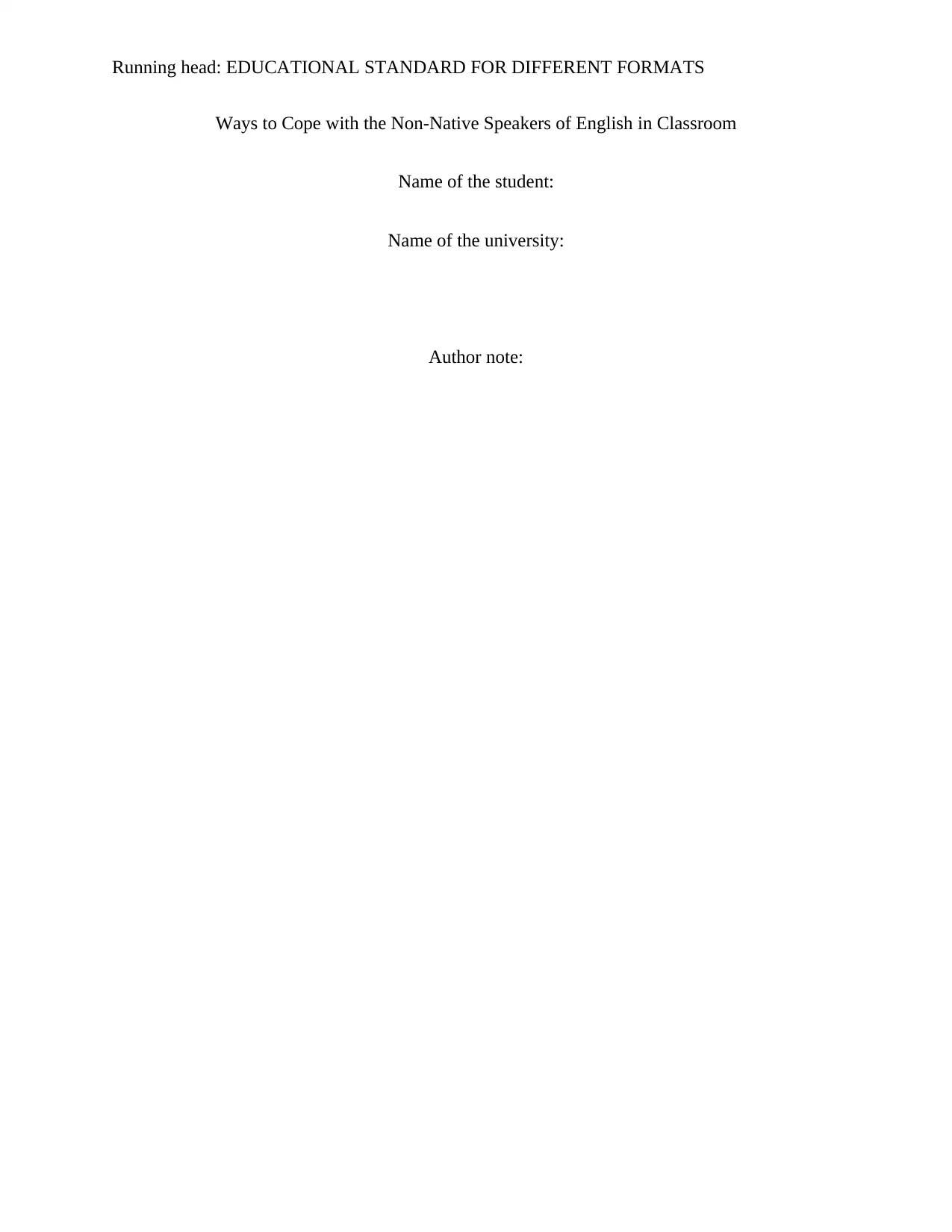
Running head: EDUCATIONAL STANDARD FOR DIFFERENT FORMATS
Ways to Cope with the Non-Native Speakers of English in Classroom
Name of the student:
Name of the university:
Author note:
Ways to Cope with the Non-Native Speakers of English in Classroom
Name of the student:
Name of the university:
Author note:
Secure Best Marks with AI Grader
Need help grading? Try our AI Grader for instant feedback on your assignments.
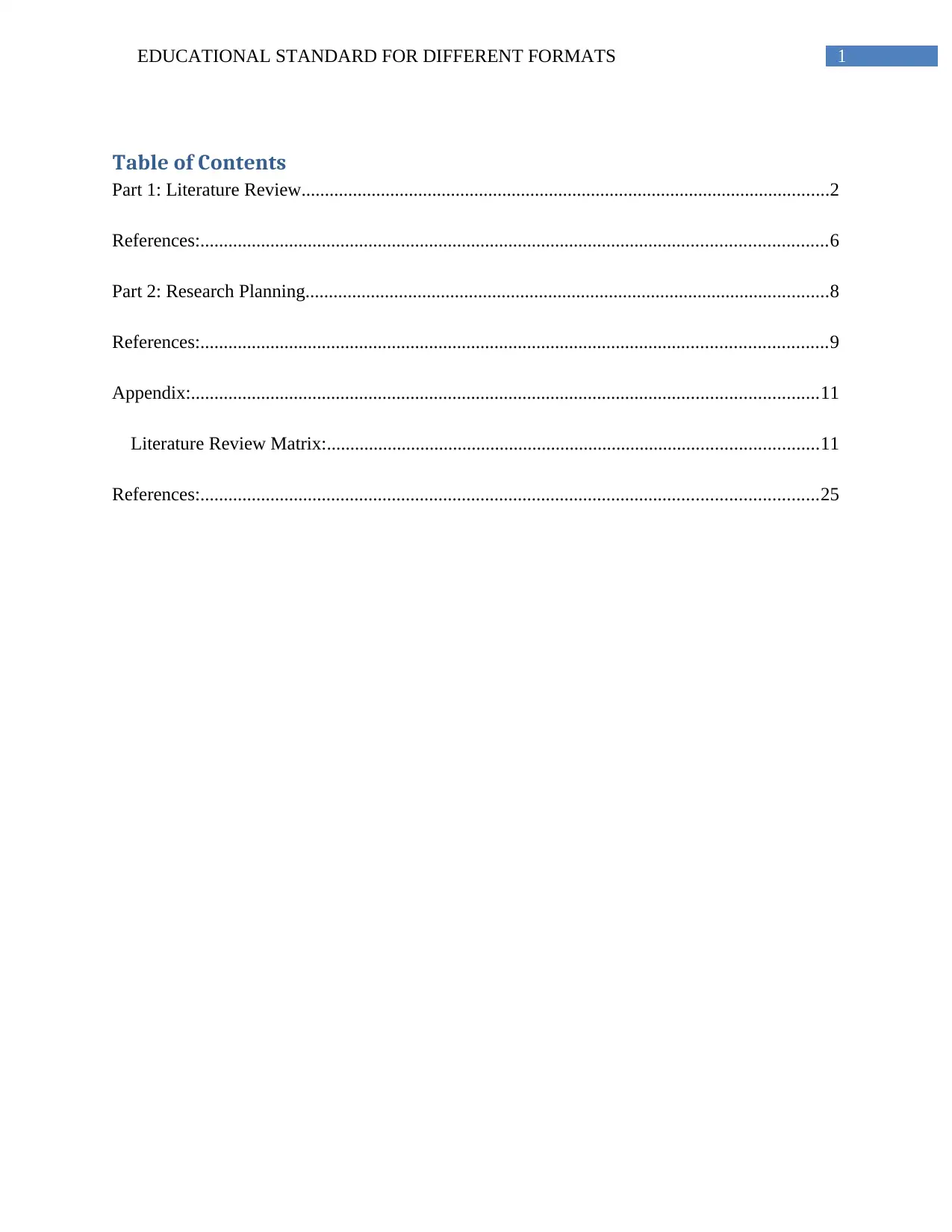
1EDUCATIONAL STANDARD FOR DIFFERENT FORMATS
Table of Contents
Part 1: Literature Review.................................................................................................................2
References:......................................................................................................................................6
Part 2: Research Planning................................................................................................................8
References:......................................................................................................................................9
Appendix:......................................................................................................................................11
Literature Review Matrix:.........................................................................................................11
References:....................................................................................................................................25
Table of Contents
Part 1: Literature Review.................................................................................................................2
References:......................................................................................................................................6
Part 2: Research Planning................................................................................................................8
References:......................................................................................................................................9
Appendix:......................................................................................................................................11
Literature Review Matrix:.........................................................................................................11
References:....................................................................................................................................25
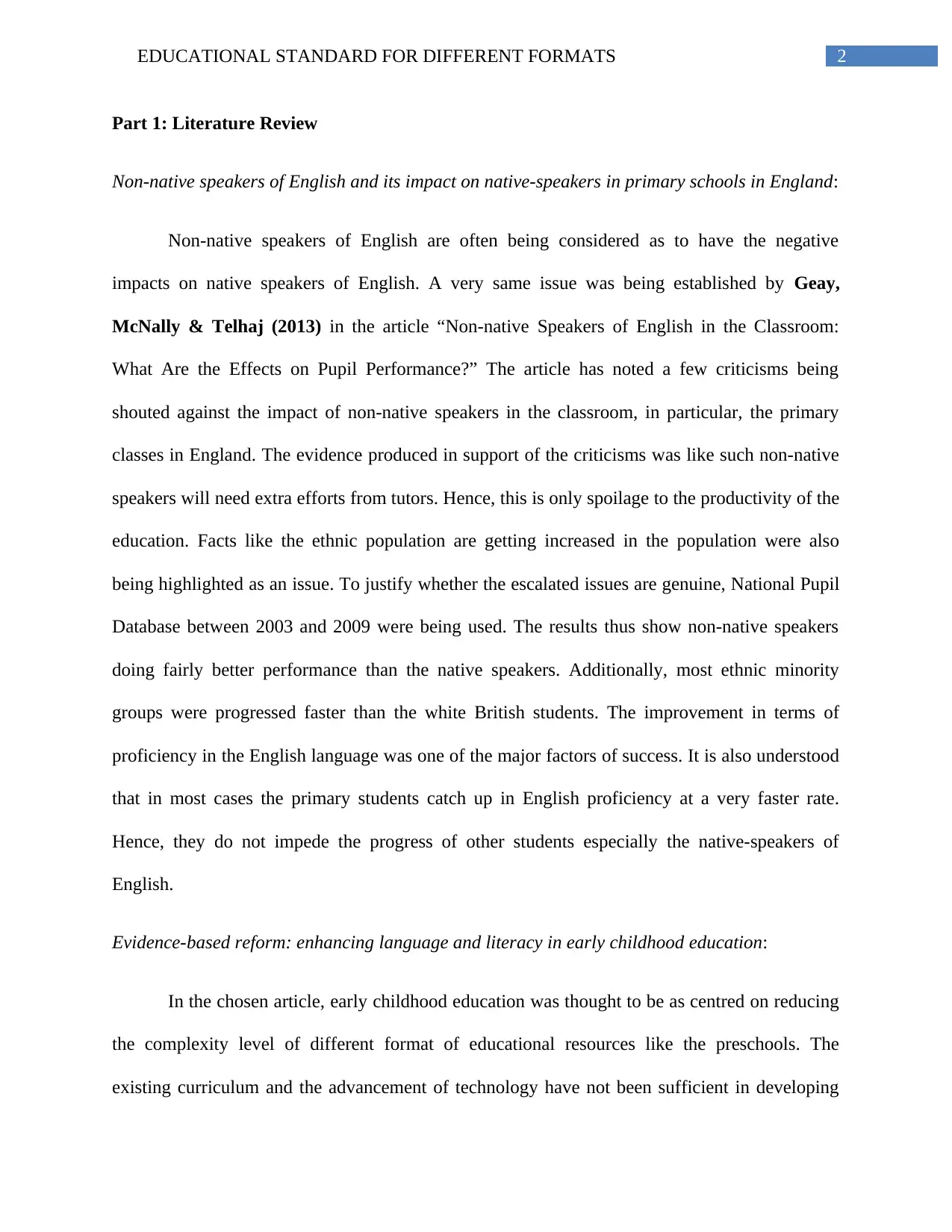
2EDUCATIONAL STANDARD FOR DIFFERENT FORMATS
Part 1: Literature Review
Non-native speakers of English and its impact on native-speakers in primary schools in England:
Non-native speakers of English are often being considered as to have the negative
impacts on native speakers of English. A very same issue was being established by Geay,
McNally & Telhaj (2013) in the article “Non‐native Speakers of English in the Classroom:
What Are the Effects on Pupil Performance?” The article has noted a few criticisms being
shouted against the impact of non-native speakers in the classroom, in particular, the primary
classes in England. The evidence produced in support of the criticisms was like such non-native
speakers will need extra efforts from tutors. Hence, this is only spoilage to the productivity of the
education. Facts like the ethnic population are getting increased in the population were also
being highlighted as an issue. To justify whether the escalated issues are genuine, National Pupil
Database between 2003 and 2009 were being used. The results thus show non-native speakers
doing fairly better performance than the native speakers. Additionally, most ethnic minority
groups were progressed faster than the white British students. The improvement in terms of
proficiency in the English language was one of the major factors of success. It is also understood
that in most cases the primary students catch up in English proficiency at a very faster rate.
Hence, they do not impede the progress of other students especially the native-speakers of
English.
Evidence-based reform: enhancing language and literacy in early childhood education:
In the chosen article, early childhood education was thought to be as centred on reducing
the complexity level of different format of educational resources like the preschools. The
existing curriculum and the advancement of technology have not been sufficient in developing
Part 1: Literature Review
Non-native speakers of English and its impact on native-speakers in primary schools in England:
Non-native speakers of English are often being considered as to have the negative
impacts on native speakers of English. A very same issue was being established by Geay,
McNally & Telhaj (2013) in the article “Non‐native Speakers of English in the Classroom:
What Are the Effects on Pupil Performance?” The article has noted a few criticisms being
shouted against the impact of non-native speakers in the classroom, in particular, the primary
classes in England. The evidence produced in support of the criticisms was like such non-native
speakers will need extra efforts from tutors. Hence, this is only spoilage to the productivity of the
education. Facts like the ethnic population are getting increased in the population were also
being highlighted as an issue. To justify whether the escalated issues are genuine, National Pupil
Database between 2003 and 2009 were being used. The results thus show non-native speakers
doing fairly better performance than the native speakers. Additionally, most ethnic minority
groups were progressed faster than the white British students. The improvement in terms of
proficiency in the English language was one of the major factors of success. It is also understood
that in most cases the primary students catch up in English proficiency at a very faster rate.
Hence, they do not impede the progress of other students especially the native-speakers of
English.
Evidence-based reform: enhancing language and literacy in early childhood education:
In the chosen article, early childhood education was thought to be as centred on reducing
the complexity level of different format of educational resources like the preschools. The
existing curriculum and the advancement of technology have not been sufficient in developing
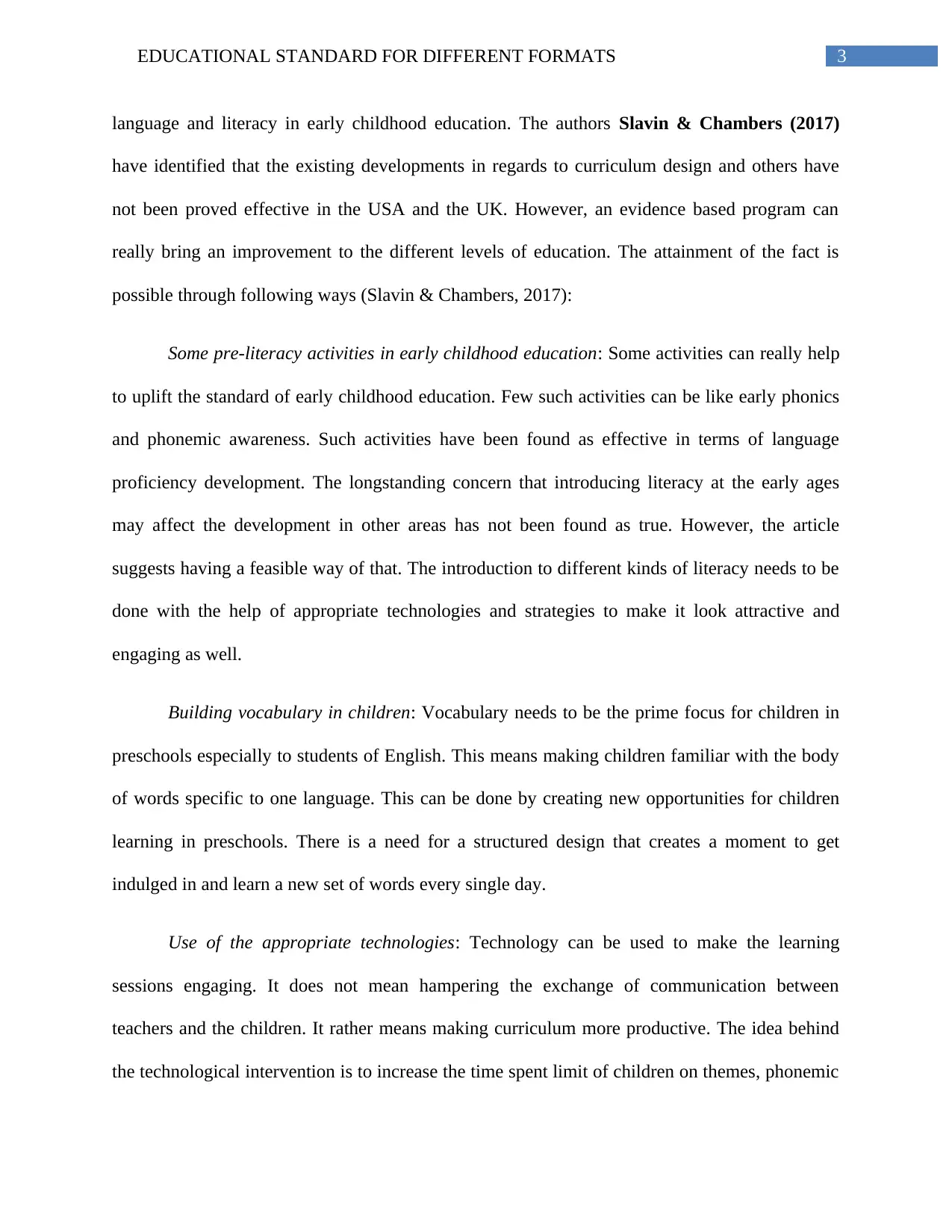
3EDUCATIONAL STANDARD FOR DIFFERENT FORMATS
language and literacy in early childhood education. The authors Slavin & Chambers (2017)
have identified that the existing developments in regards to curriculum design and others have
not been proved effective in the USA and the UK. However, an evidence based program can
really bring an improvement to the different levels of education. The attainment of the fact is
possible through following ways (Slavin & Chambers, 2017):
Some pre-literacy activities in early childhood education: Some activities can really help
to uplift the standard of early childhood education. Few such activities can be like early phonics
and phonemic awareness. Such activities have been found as effective in terms of language
proficiency development. The longstanding concern that introducing literacy at the early ages
may affect the development in other areas has not been found as true. However, the article
suggests having a feasible way of that. The introduction to different kinds of literacy needs to be
done with the help of appropriate technologies and strategies to make it look attractive and
engaging as well.
Building vocabulary in children: Vocabulary needs to be the prime focus for children in
preschools especially to students of English. This means making children familiar with the body
of words specific to one language. This can be done by creating new opportunities for children
learning in preschools. There is a need for a structured design that creates a moment to get
indulged in and learn a new set of words every single day.
Use of the appropriate technologies: Technology can be used to make the learning
sessions engaging. It does not mean hampering the exchange of communication between
teachers and the children. It rather means making curriculum more productive. The idea behind
the technological intervention is to increase the time spent limit of children on themes, phonemic
language and literacy in early childhood education. The authors Slavin & Chambers (2017)
have identified that the existing developments in regards to curriculum design and others have
not been proved effective in the USA and the UK. However, an evidence based program can
really bring an improvement to the different levels of education. The attainment of the fact is
possible through following ways (Slavin & Chambers, 2017):
Some pre-literacy activities in early childhood education: Some activities can really help
to uplift the standard of early childhood education. Few such activities can be like early phonics
and phonemic awareness. Such activities have been found as effective in terms of language
proficiency development. The longstanding concern that introducing literacy at the early ages
may affect the development in other areas has not been found as true. However, the article
suggests having a feasible way of that. The introduction to different kinds of literacy needs to be
done with the help of appropriate technologies and strategies to make it look attractive and
engaging as well.
Building vocabulary in children: Vocabulary needs to be the prime focus for children in
preschools especially to students of English. This means making children familiar with the body
of words specific to one language. This can be done by creating new opportunities for children
learning in preschools. There is a need for a structured design that creates a moment to get
indulged in and learn a new set of words every single day.
Use of the appropriate technologies: Technology can be used to make the learning
sessions engaging. It does not mean hampering the exchange of communication between
teachers and the children. It rather means making curriculum more productive. The idea behind
the technological intervention is to increase the time spent limit of children on themes, phonemic
Secure Best Marks with AI Grader
Need help grading? Try our AI Grader for instant feedback on your assignments.
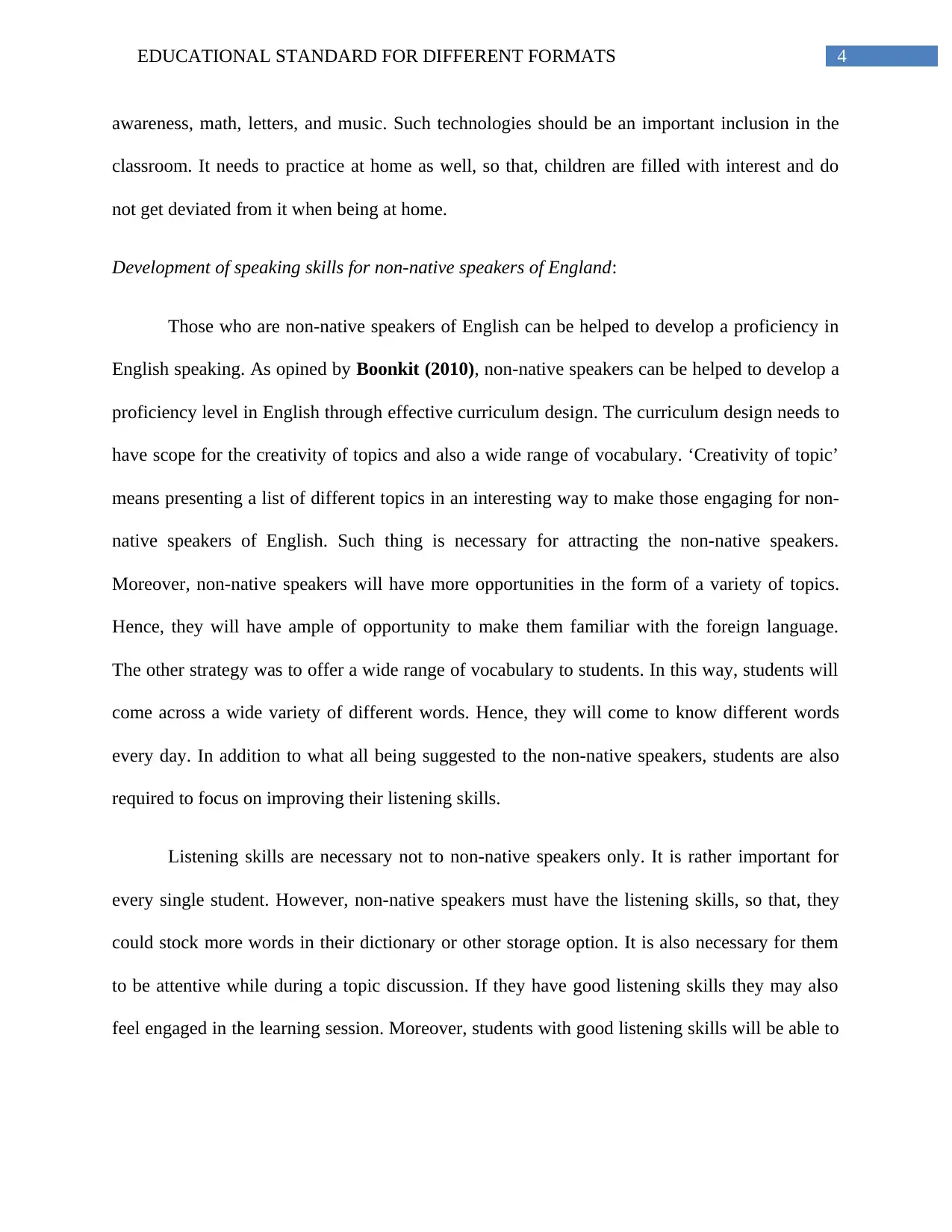
4EDUCATIONAL STANDARD FOR DIFFERENT FORMATS
awareness, math, letters, and music. Such technologies should be an important inclusion in the
classroom. It needs to practice at home as well, so that, children are filled with interest and do
not get deviated from it when being at home.
Development of speaking skills for non-native speakers of England:
Those who are non-native speakers of English can be helped to develop a proficiency in
English speaking. As opined by Boonkit (2010), non-native speakers can be helped to develop a
proficiency level in English through effective curriculum design. The curriculum design needs to
have scope for the creativity of topics and also a wide range of vocabulary. ‘Creativity of topic’
means presenting a list of different topics in an interesting way to make those engaging for non-
native speakers of English. Such thing is necessary for attracting the non-native speakers.
Moreover, non-native speakers will have more opportunities in the form of a variety of topics.
Hence, they will have ample of opportunity to make them familiar with the foreign language.
The other strategy was to offer a wide range of vocabulary to students. In this way, students will
come across a wide variety of different words. Hence, they will come to know different words
every day. In addition to what all being suggested to the non-native speakers, students are also
required to focus on improving their listening skills.
Listening skills are necessary not to non-native speakers only. It is rather important for
every single student. However, non-native speakers must have the listening skills, so that, they
could stock more words in their dictionary or other storage option. It is also necessary for them
to be attentive while during a topic discussion. If they have good listening skills they may also
feel engaged in the learning session. Moreover, students with good listening skills will be able to
awareness, math, letters, and music. Such technologies should be an important inclusion in the
classroom. It needs to practice at home as well, so that, children are filled with interest and do
not get deviated from it when being at home.
Development of speaking skills for non-native speakers of England:
Those who are non-native speakers of English can be helped to develop a proficiency in
English speaking. As opined by Boonkit (2010), non-native speakers can be helped to develop a
proficiency level in English through effective curriculum design. The curriculum design needs to
have scope for the creativity of topics and also a wide range of vocabulary. ‘Creativity of topic’
means presenting a list of different topics in an interesting way to make those engaging for non-
native speakers of English. Such thing is necessary for attracting the non-native speakers.
Moreover, non-native speakers will have more opportunities in the form of a variety of topics.
Hence, they will have ample of opportunity to make them familiar with the foreign language.
The other strategy was to offer a wide range of vocabulary to students. In this way, students will
come across a wide variety of different words. Hence, they will come to know different words
every day. In addition to what all being suggested to the non-native speakers, students are also
required to focus on improving their listening skills.
Listening skills are necessary not to non-native speakers only. It is rather important for
every single student. However, non-native speakers must have the listening skills, so that, they
could stock more words in their dictionary or other storage option. It is also necessary for them
to be attentive while during a topic discussion. If they have good listening skills they may also
feel engaged in the learning session. Moreover, students with good listening skills will be able to
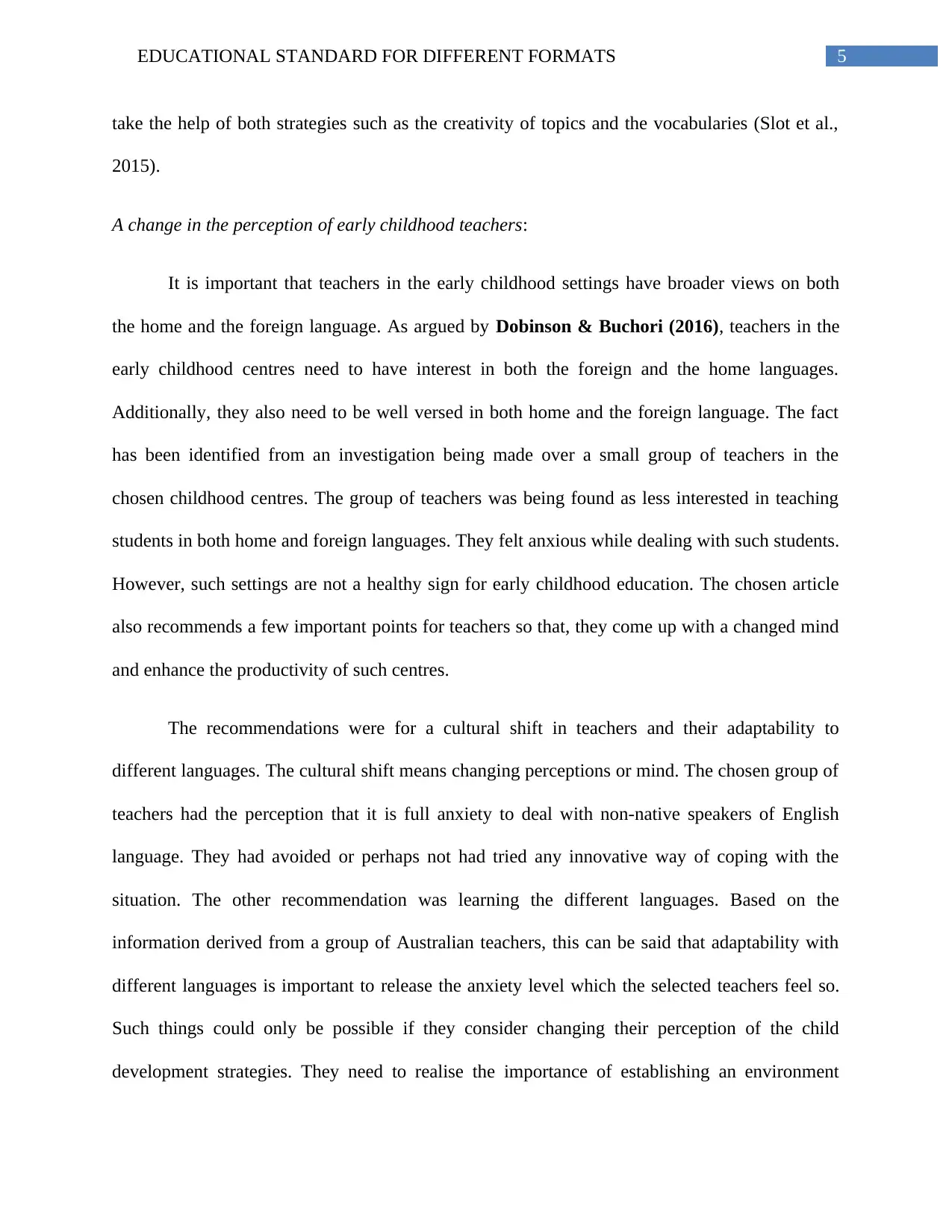
5EDUCATIONAL STANDARD FOR DIFFERENT FORMATS
take the help of both strategies such as the creativity of topics and the vocabularies (Slot et al.,
2015).
A change in the perception of early childhood teachers:
It is important that teachers in the early childhood settings have broader views on both
the home and the foreign language. As argued by Dobinson & Buchori (2016), teachers in the
early childhood centres need to have interest in both the foreign and the home languages.
Additionally, they also need to be well versed in both home and the foreign language. The fact
has been identified from an investigation being made over a small group of teachers in the
chosen childhood centres. The group of teachers was being found as less interested in teaching
students in both home and foreign languages. They felt anxious while dealing with such students.
However, such settings are not a healthy sign for early childhood education. The chosen article
also recommends a few important points for teachers so that, they come up with a changed mind
and enhance the productivity of such centres.
The recommendations were for a cultural shift in teachers and their adaptability to
different languages. The cultural shift means changing perceptions or mind. The chosen group of
teachers had the perception that it is full anxiety to deal with non-native speakers of English
language. They had avoided or perhaps not had tried any innovative way of coping with the
situation. The other recommendation was learning the different languages. Based on the
information derived from a group of Australian teachers, this can be said that adaptability with
different languages is important to release the anxiety level which the selected teachers feel so.
Such things could only be possible if they consider changing their perception of the child
development strategies. They need to realise the importance of establishing an environment
take the help of both strategies such as the creativity of topics and the vocabularies (Slot et al.,
2015).
A change in the perception of early childhood teachers:
It is important that teachers in the early childhood settings have broader views on both
the home and the foreign language. As argued by Dobinson & Buchori (2016), teachers in the
early childhood centres need to have interest in both the foreign and the home languages.
Additionally, they also need to be well versed in both home and the foreign language. The fact
has been identified from an investigation being made over a small group of teachers in the
chosen childhood centres. The group of teachers was being found as less interested in teaching
students in both home and foreign languages. They felt anxious while dealing with such students.
However, such settings are not a healthy sign for early childhood education. The chosen article
also recommends a few important points for teachers so that, they come up with a changed mind
and enhance the productivity of such centres.
The recommendations were for a cultural shift in teachers and their adaptability to
different languages. The cultural shift means changing perceptions or mind. The chosen group of
teachers had the perception that it is full anxiety to deal with non-native speakers of English
language. They had avoided or perhaps not had tried any innovative way of coping with the
situation. The other recommendation was learning the different languages. Based on the
information derived from a group of Australian teachers, this can be said that adaptability with
different languages is important to release the anxiety level which the selected teachers feel so.
Such things could only be possible if they consider changing their perception of the child
development strategies. They need to realise the importance of establishing an environment
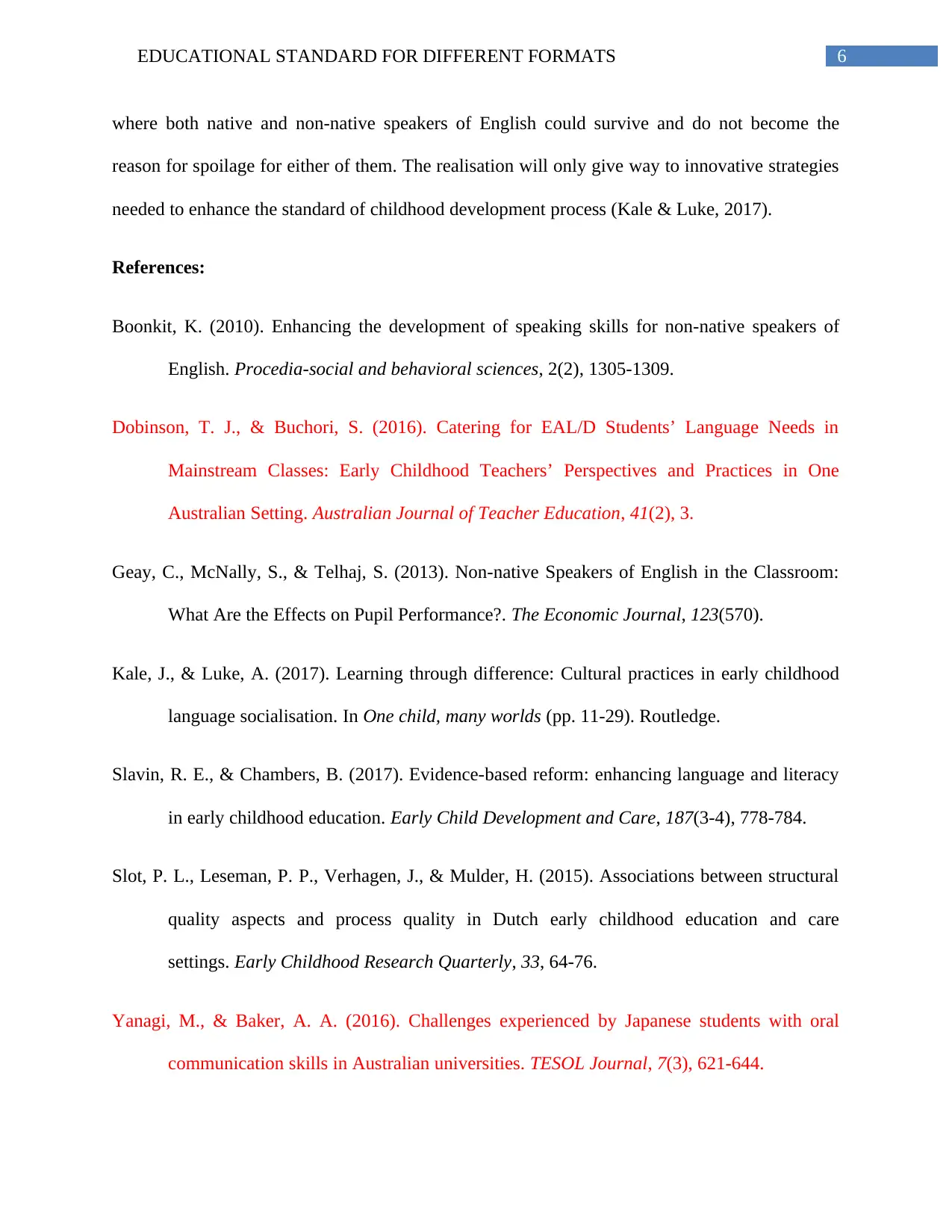
6EDUCATIONAL STANDARD FOR DIFFERENT FORMATS
where both native and non-native speakers of English could survive and do not become the
reason for spoilage for either of them. The realisation will only give way to innovative strategies
needed to enhance the standard of childhood development process (Kale & Luke, 2017).
References:
Boonkit, K. (2010). Enhancing the development of speaking skills for non-native speakers of
English. Procedia-social and behavioral sciences, 2(2), 1305-1309.
Dobinson, T. J., & Buchori, S. (2016). Catering for EAL/D Students’ Language Needs in
Mainstream Classes: Early Childhood Teachers’ Perspectives and Practices in One
Australian Setting. Australian Journal of Teacher Education, 41(2), 3.
Geay, C., McNally, S., & Telhaj, S. (2013). Non‐native Speakers of English in the Classroom:
What Are the Effects on Pupil Performance?. The Economic Journal, 123(570).
Kale, J., & Luke, A. (2017). Learning through difference: Cultural practices in early childhood
language socialisation. In One child, many worlds (pp. 11-29). Routledge.
Slavin, R. E., & Chambers, B. (2017). Evidence-based reform: enhancing language and literacy
in early childhood education. Early Child Development and Care, 187(3-4), 778-784.
Slot, P. L., Leseman, P. P., Verhagen, J., & Mulder, H. (2015). Associations between structural
quality aspects and process quality in Dutch early childhood education and care
settings. Early Childhood Research Quarterly, 33, 64-76.
Yanagi, M., & Baker, A. A. (2016). Challenges experienced by Japanese students with oral
communication skills in Australian universities. TESOL Journal, 7(3), 621-644.
where both native and non-native speakers of English could survive and do not become the
reason for spoilage for either of them. The realisation will only give way to innovative strategies
needed to enhance the standard of childhood development process (Kale & Luke, 2017).
References:
Boonkit, K. (2010). Enhancing the development of speaking skills for non-native speakers of
English. Procedia-social and behavioral sciences, 2(2), 1305-1309.
Dobinson, T. J., & Buchori, S. (2016). Catering for EAL/D Students’ Language Needs in
Mainstream Classes: Early Childhood Teachers’ Perspectives and Practices in One
Australian Setting. Australian Journal of Teacher Education, 41(2), 3.
Geay, C., McNally, S., & Telhaj, S. (2013). Non‐native Speakers of English in the Classroom:
What Are the Effects on Pupil Performance?. The Economic Journal, 123(570).
Kale, J., & Luke, A. (2017). Learning through difference: Cultural practices in early childhood
language socialisation. In One child, many worlds (pp. 11-29). Routledge.
Slavin, R. E., & Chambers, B. (2017). Evidence-based reform: enhancing language and literacy
in early childhood education. Early Child Development and Care, 187(3-4), 778-784.
Slot, P. L., Leseman, P. P., Verhagen, J., & Mulder, H. (2015). Associations between structural
quality aspects and process quality in Dutch early childhood education and care
settings. Early Childhood Research Quarterly, 33, 64-76.
Yanagi, M., & Baker, A. A. (2016). Challenges experienced by Japanese students with oral
communication skills in Australian universities. TESOL Journal, 7(3), 621-644.
Paraphrase This Document
Need a fresh take? Get an instant paraphrase of this document with our AI Paraphraser
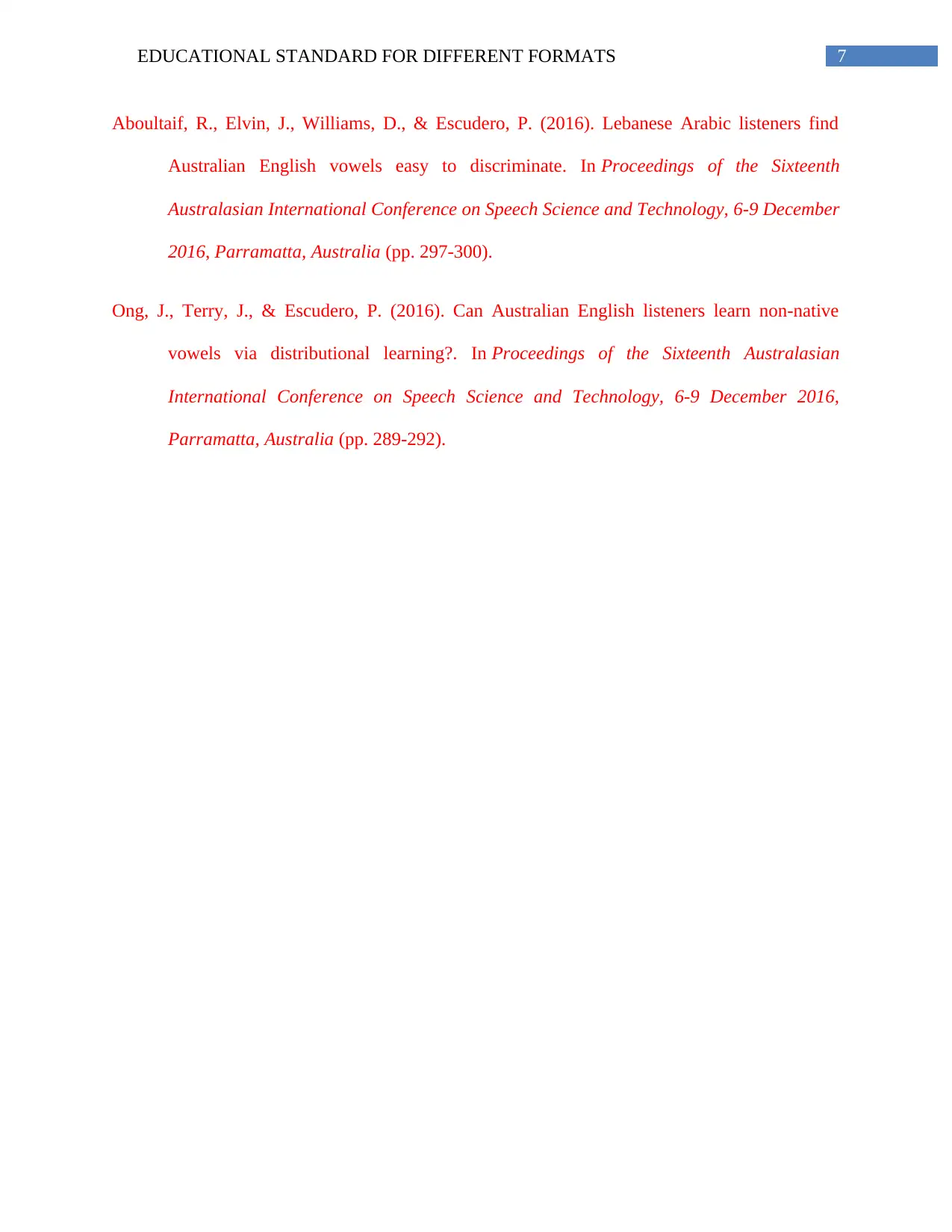
7EDUCATIONAL STANDARD FOR DIFFERENT FORMATS
Aboultaif, R., Elvin, J., Williams, D., & Escudero, P. (2016). Lebanese Arabic listeners find
Australian English vowels easy to discriminate. In Proceedings of the Sixteenth
Australasian International Conference on Speech Science and Technology, 6-9 December
2016, Parramatta, Australia (pp. 297-300).
Ong, J., Terry, J., & Escudero, P. (2016). Can Australian English listeners learn non-native
vowels via distributional learning?. In Proceedings of the Sixteenth Australasian
International Conference on Speech Science and Technology, 6-9 December 2016,
Parramatta, Australia (pp. 289-292).
Aboultaif, R., Elvin, J., Williams, D., & Escudero, P. (2016). Lebanese Arabic listeners find
Australian English vowels easy to discriminate. In Proceedings of the Sixteenth
Australasian International Conference on Speech Science and Technology, 6-9 December
2016, Parramatta, Australia (pp. 297-300).
Ong, J., Terry, J., & Escudero, P. (2016). Can Australian English listeners learn non-native
vowels via distributional learning?. In Proceedings of the Sixteenth Australasian
International Conference on Speech Science and Technology, 6-9 December 2016,
Parramatta, Australia (pp. 289-292).

8EDUCATIONAL STANDARD FOR DIFFERENT FORMATS
Part 2: Research Planning
RE: Discussion Topic 1: Action Research as a Paradigm in Practice
Topic 1
On the basis of my reading on Pine’s (2009), The Disconnection between Educational
Research and practice, the teacher-action research is a pragmatic approach as it promotes an
egalitarian, democratic, participatory and non-hierarchical leadership to be displayed by the
teachers. In this type of research, there is encouragement to enquire about the school and its
various policies that includes questioning the learning, teaching, improvement and development.
This approach emboldens the teachers to engage in consciousness raising and collaborative
research. My action research approach that I believe are appropriate and closely related would be
the participatory and collaborative action research.
The nature and course of my research has convergence with the research of example 2,
Christine an action researcher within an LEA. It is because her research also entailed selection of
children as participants by their respective class teachers. In similar lines to my research in which
there would be workshops for children, Christine’s action research too incorporates enrichment
program to be attended by the children. Christine’s research employs a variety of methods like
interview with the children, photography along with seeking the viewpoints of multiple
stakeholders of the research as well as reflection and Julian’s systematic element which I will
also will be working with individual children and check their progress (Koshy, 2005). My
research design is in consonance with the elements and values of example three- Julian who is a
year 4 teacher (Koshy, 2005). Julian’s research was concerned with assessment of effectiveness
of children’s level of understanding, rectification of the misconceptions and suggestions to
Part 2: Research Planning
RE: Discussion Topic 1: Action Research as a Paradigm in Practice
Topic 1
On the basis of my reading on Pine’s (2009), The Disconnection between Educational
Research and practice, the teacher-action research is a pragmatic approach as it promotes an
egalitarian, democratic, participatory and non-hierarchical leadership to be displayed by the
teachers. In this type of research, there is encouragement to enquire about the school and its
various policies that includes questioning the learning, teaching, improvement and development.
This approach emboldens the teachers to engage in consciousness raising and collaborative
research. My action research approach that I believe are appropriate and closely related would be
the participatory and collaborative action research.
The nature and course of my research has convergence with the research of example 2,
Christine an action researcher within an LEA. It is because her research also entailed selection of
children as participants by their respective class teachers. In similar lines to my research in which
there would be workshops for children, Christine’s action research too incorporates enrichment
program to be attended by the children. Christine’s research employs a variety of methods like
interview with the children, photography along with seeking the viewpoints of multiple
stakeholders of the research as well as reflection and Julian’s systematic element which I will
also will be working with individual children and check their progress (Koshy, 2005). My
research design is in consonance with the elements and values of example three- Julian who is a
year 4 teacher (Koshy, 2005). Julian’s research was concerned with assessment of effectiveness
of children’s level of understanding, rectification of the misconceptions and suggestions to
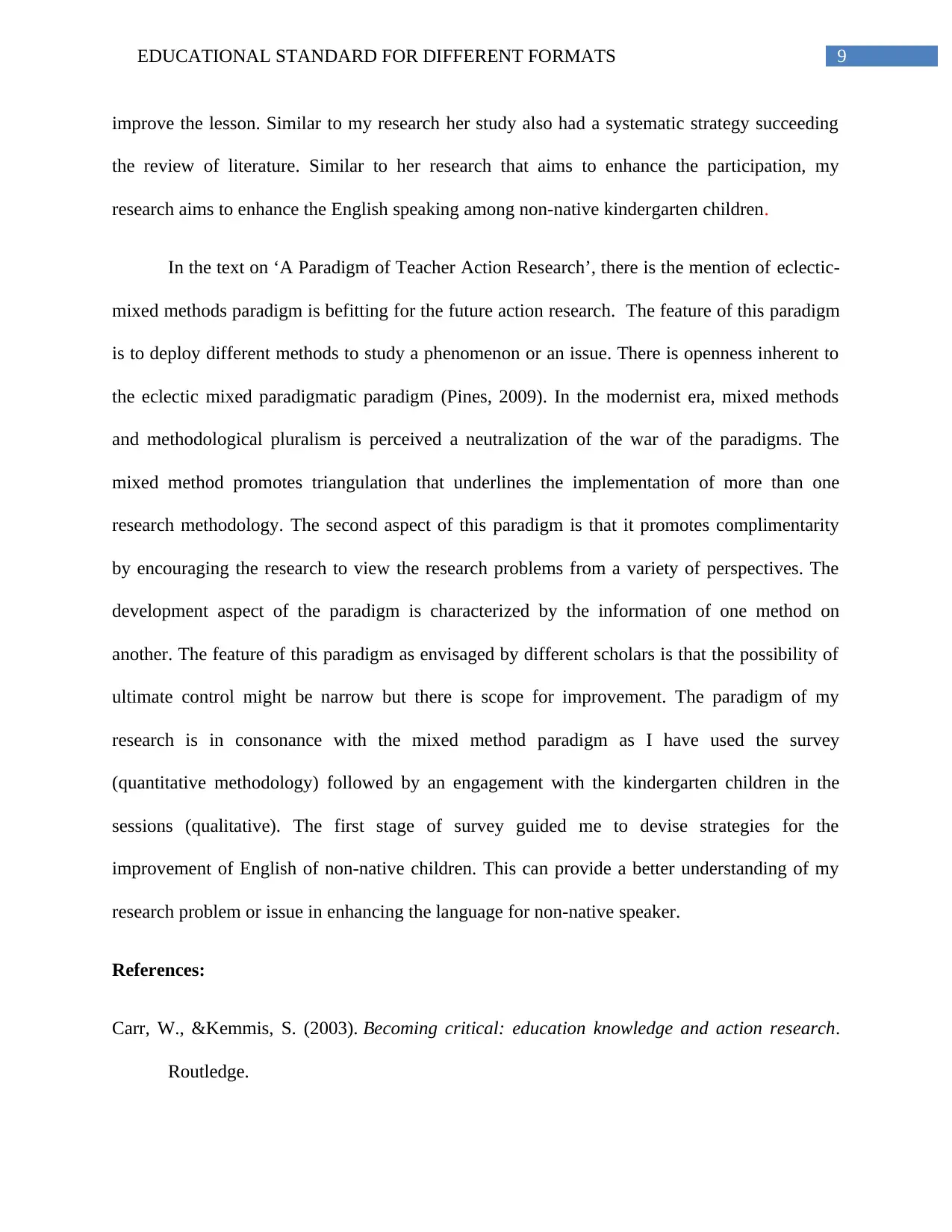
9EDUCATIONAL STANDARD FOR DIFFERENT FORMATS
improve the lesson. Similar to my research her study also had a systematic strategy succeeding
the review of literature. Similar to her research that aims to enhance the participation, my
research aims to enhance the English speaking among non-native kindergarten children.
In the text on ‘A Paradigm of Teacher Action Research’, there is the mention of eclectic-
mixed methods paradigm is befitting for the future action research. The feature of this paradigm
is to deploy different methods to study a phenomenon or an issue. There is openness inherent to
the eclectic mixed paradigmatic paradigm (Pines, 2009). In the modernist era, mixed methods
and methodological pluralism is perceived a neutralization of the war of the paradigms. The
mixed method promotes triangulation that underlines the implementation of more than one
research methodology. The second aspect of this paradigm is that it promotes complimentarity
by encouraging the research to view the research problems from a variety of perspectives. The
development aspect of the paradigm is characterized by the information of one method on
another. The feature of this paradigm as envisaged by different scholars is that the possibility of
ultimate control might be narrow but there is scope for improvement. The paradigm of my
research is in consonance with the mixed method paradigm as I have used the survey
(quantitative methodology) followed by an engagement with the kindergarten children in the
sessions (qualitative). The first stage of survey guided me to devise strategies for the
improvement of English of non-native children. This can provide a better understanding of my
research problem or issue in enhancing the language for non-native speaker.
References:
Carr, W., &Kemmis, S. (2003). Becoming critical: education knowledge and action research.
Routledge.
improve the lesson. Similar to my research her study also had a systematic strategy succeeding
the review of literature. Similar to her research that aims to enhance the participation, my
research aims to enhance the English speaking among non-native kindergarten children.
In the text on ‘A Paradigm of Teacher Action Research’, there is the mention of eclectic-
mixed methods paradigm is befitting for the future action research. The feature of this paradigm
is to deploy different methods to study a phenomenon or an issue. There is openness inherent to
the eclectic mixed paradigmatic paradigm (Pines, 2009). In the modernist era, mixed methods
and methodological pluralism is perceived a neutralization of the war of the paradigms. The
mixed method promotes triangulation that underlines the implementation of more than one
research methodology. The second aspect of this paradigm is that it promotes complimentarity
by encouraging the research to view the research problems from a variety of perspectives. The
development aspect of the paradigm is characterized by the information of one method on
another. The feature of this paradigm as envisaged by different scholars is that the possibility of
ultimate control might be narrow but there is scope for improvement. The paradigm of my
research is in consonance with the mixed method paradigm as I have used the survey
(quantitative methodology) followed by an engagement with the kindergarten children in the
sessions (qualitative). The first stage of survey guided me to devise strategies for the
improvement of English of non-native children. This can provide a better understanding of my
research problem or issue in enhancing the language for non-native speaker.
References:
Carr, W., &Kemmis, S. (2003). Becoming critical: education knowledge and action research.
Routledge.
Secure Best Marks with AI Grader
Need help grading? Try our AI Grader for instant feedback on your assignments.
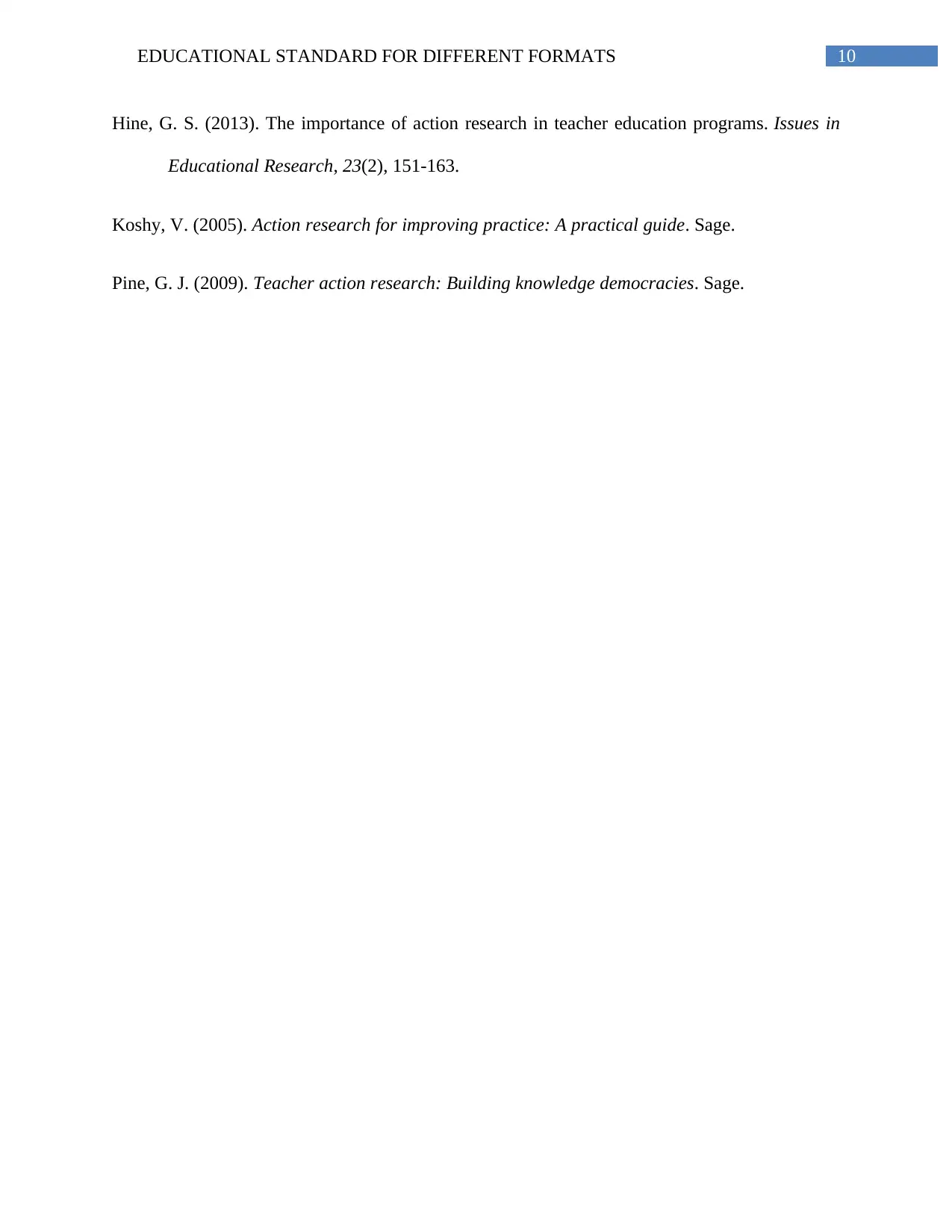
10EDUCATIONAL STANDARD FOR DIFFERENT FORMATS
Hine, G. S. (2013). The importance of action research in teacher education programs. Issues in
Educational Research, 23(2), 151-163.
Koshy, V. (2005). Action research for improving practice: A practical guide. Sage.
Pine, G. J. (2009). Teacher action research: Building knowledge democracies. Sage.
Hine, G. S. (2013). The importance of action research in teacher education programs. Issues in
Educational Research, 23(2), 151-163.
Koshy, V. (2005). Action research for improving practice: A practical guide. Sage.
Pine, G. J. (2009). Teacher action research: Building knowledge democracies. Sage.
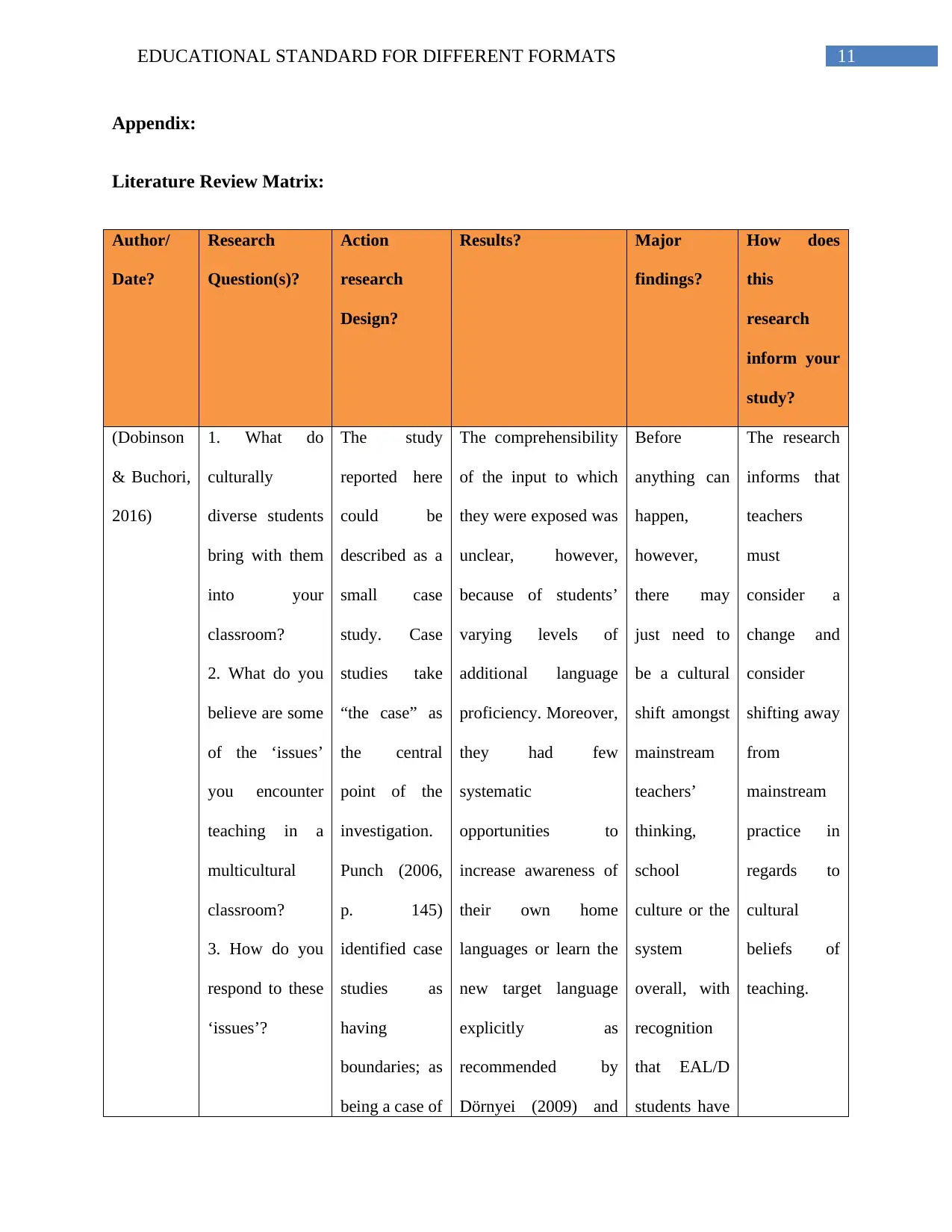
11EDUCATIONAL STANDARD FOR DIFFERENT FORMATS
Appendix:
Literature Review Matrix:
Author/
Date?
Research
Question(s)?
Action
research
Design?
Results? Major
findings?
How does
this
research
inform your
study?
(Dobinson
& Buchori,
2016)
1. What do
culturally
diverse students
bring with them
into your
classroom?
2. What do you
believe are some
of the ‘issues’
you encounter
teaching in a
multicultural
classroom?
3. How do you
respond to these
‘issues’?
The study
reported here
could be
described as a
small case
study. Case
studies take
“the case” as
the central
point of the
investigation.
Punch (2006,
p. 145)
identified case
studies as
having
boundaries; as
being a case of
The comprehensibility
of the input to which
they were exposed was
unclear, however,
because of students’
varying levels of
additional language
proficiency. Moreover,
they had few
systematic
opportunities to
increase awareness of
their own home
languages or learn the
new target language
explicitly as
recommended by
Dörnyei (2009) and
Before
anything can
happen,
however,
there may
just need to
be a cultural
shift amongst
mainstream
teachers’
thinking,
school
culture or the
system
overall, with
recognition
that EAL/D
students have
The research
informs that
teachers
must
consider a
change and
consider
shifting away
from
mainstream
practice in
regards to
cultural
beliefs of
teaching.
Appendix:
Literature Review Matrix:
Author/
Date?
Research
Question(s)?
Action
research
Design?
Results? Major
findings?
How does
this
research
inform your
study?
(Dobinson
& Buchori,
2016)
1. What do
culturally
diverse students
bring with them
into your
classroom?
2. What do you
believe are some
of the ‘issues’
you encounter
teaching in a
multicultural
classroom?
3. How do you
respond to these
‘issues’?
The study
reported here
could be
described as a
small case
study. Case
studies take
“the case” as
the central
point of the
investigation.
Punch (2006,
p. 145)
identified case
studies as
having
boundaries; as
being a case of
The comprehensibility
of the input to which
they were exposed was
unclear, however,
because of students’
varying levels of
additional language
proficiency. Moreover,
they had few
systematic
opportunities to
increase awareness of
their own home
languages or learn the
new target language
explicitly as
recommended by
Dörnyei (2009) and
Before
anything can
happen,
however,
there may
just need to
be a cultural
shift amongst
mainstream
teachers’
thinking,
school
culture or the
system
overall, with
recognition
that EAL/D
students have
The research
informs that
teachers
must
consider a
change and
consider
shifting away
from
mainstream
practice in
regards to
cultural
beliefs of
teaching.
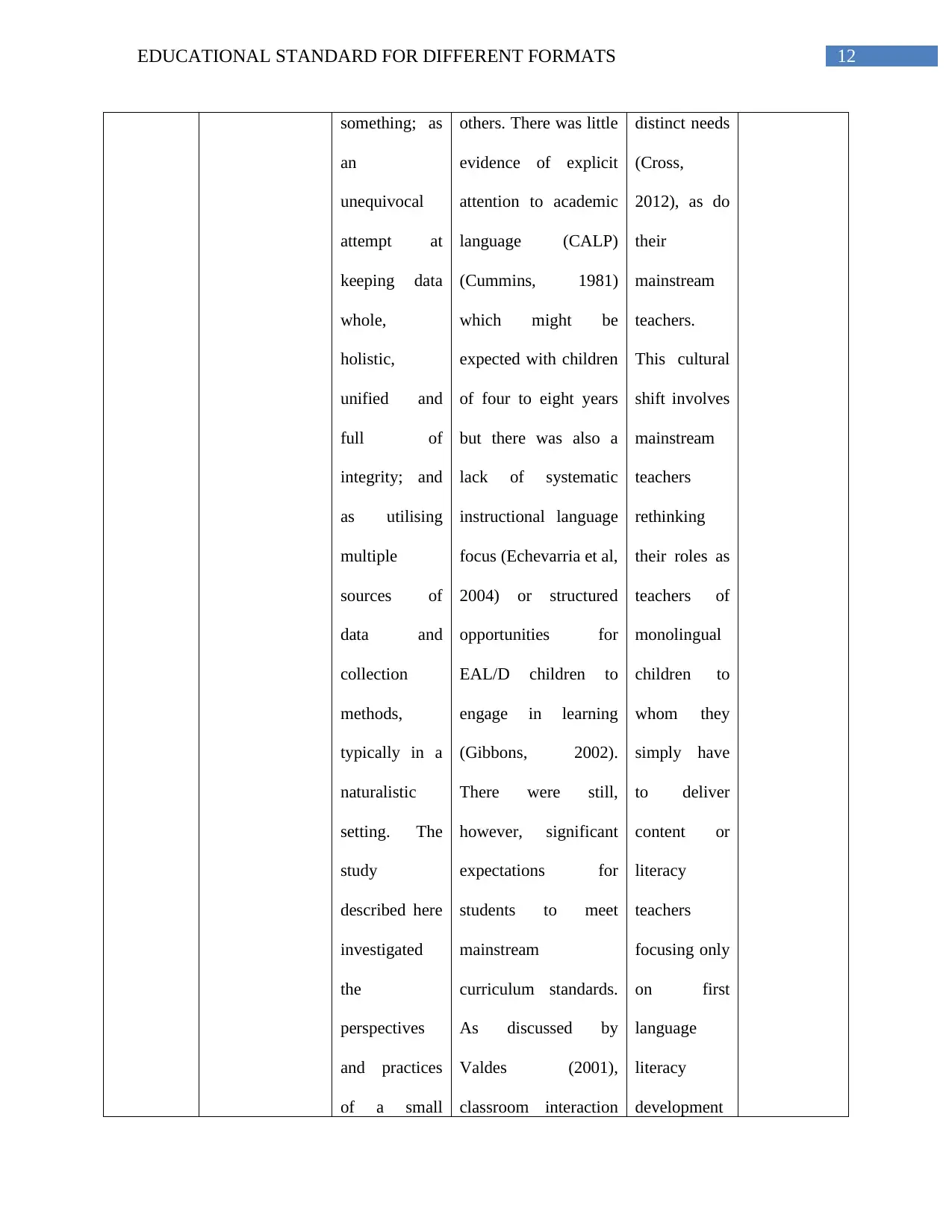
12EDUCATIONAL STANDARD FOR DIFFERENT FORMATS
something; as
an
unequivocal
attempt at
keeping data
whole,
holistic,
unified and
full of
integrity; and
as utilising
multiple
sources of
data and
collection
methods,
typically in a
naturalistic
setting. The
study
described here
investigated
the
perspectives
and practices
of a small
others. There was little
evidence of explicit
attention to academic
language (CALP)
(Cummins, 1981)
which might be
expected with children
of four to eight years
but there was also a
lack of systematic
instructional language
focus (Echevarria et al,
2004) or structured
opportunities for
EAL/D children to
engage in learning
(Gibbons, 2002).
There were still,
however, significant
expectations for
students to meet
mainstream
curriculum standards.
As discussed by
Valdes (2001),
classroom interaction
distinct needs
(Cross,
2012), as do
their
mainstream
teachers.
This cultural
shift involves
mainstream
teachers
rethinking
their roles as
teachers of
monolingual
children to
whom they
simply have
to deliver
content or
literacy
teachers
focusing only
on first
language
literacy
development
something; as
an
unequivocal
attempt at
keeping data
whole,
holistic,
unified and
full of
integrity; and
as utilising
multiple
sources of
data and
collection
methods,
typically in a
naturalistic
setting. The
study
described here
investigated
the
perspectives
and practices
of a small
others. There was little
evidence of explicit
attention to academic
language (CALP)
(Cummins, 1981)
which might be
expected with children
of four to eight years
but there was also a
lack of systematic
instructional language
focus (Echevarria et al,
2004) or structured
opportunities for
EAL/D children to
engage in learning
(Gibbons, 2002).
There were still,
however, significant
expectations for
students to meet
mainstream
curriculum standards.
As discussed by
Valdes (2001),
classroom interaction
distinct needs
(Cross,
2012), as do
their
mainstream
teachers.
This cultural
shift involves
mainstream
teachers
rethinking
their roles as
teachers of
monolingual
children to
whom they
simply have
to deliver
content or
literacy
teachers
focusing only
on first
language
literacy
development
Paraphrase This Document
Need a fresh take? Get an instant paraphrase of this document with our AI Paraphraser

13EDUCATIONAL STANDARD FOR DIFFERENT FORMATS
group of early
childhood
teachers. In
this study
qualitative,
ethnographic
data were
collected from
four early
childhood
teachers (K-2)
in an early
childhood
setting in
Australia.
could not facilitate
English language
acquisition because
teachers often
separated the EAL/D
children from the
others in order to be
able to cope as best
they could with the
different linguistic
abilities in the
classroom and meet
the required outcomes.
and
neglecting
additional
language
development.
It may also
mean that
there needs
to be a
change in the
mindset of
content
teachers as
they need to
rely more
and more
upon input
from EAL/D
specialists.
Author/
Date?
Research
Question(s)?
Action
research
Design?
Results? Major
findings?
How does
this
research
inform your
study?
(Geay,
McNally &
1. What is the
association
National Pupil
Database
This investigation
suggests that the
That non-
native
It informs
that helping
group of early
childhood
teachers. In
this study
qualitative,
ethnographic
data were
collected from
four early
childhood
teachers (K-2)
in an early
childhood
setting in
Australia.
could not facilitate
English language
acquisition because
teachers often
separated the EAL/D
children from the
others in order to be
able to cope as best
they could with the
different linguistic
abilities in the
classroom and meet
the required outcomes.
and
neglecting
additional
language
development.
It may also
mean that
there needs
to be a
change in the
mindset of
content
teachers as
they need to
rely more
and more
upon input
from EAL/D
specialists.
Author/
Date?
Research
Question(s)?
Action
research
Design?
Results? Major
findings?
How does
this
research
inform your
study?
(Geay,
McNally &
1. What is the
association
National Pupil
Database
This investigation
suggests that the
That non-
native
It informs
that helping
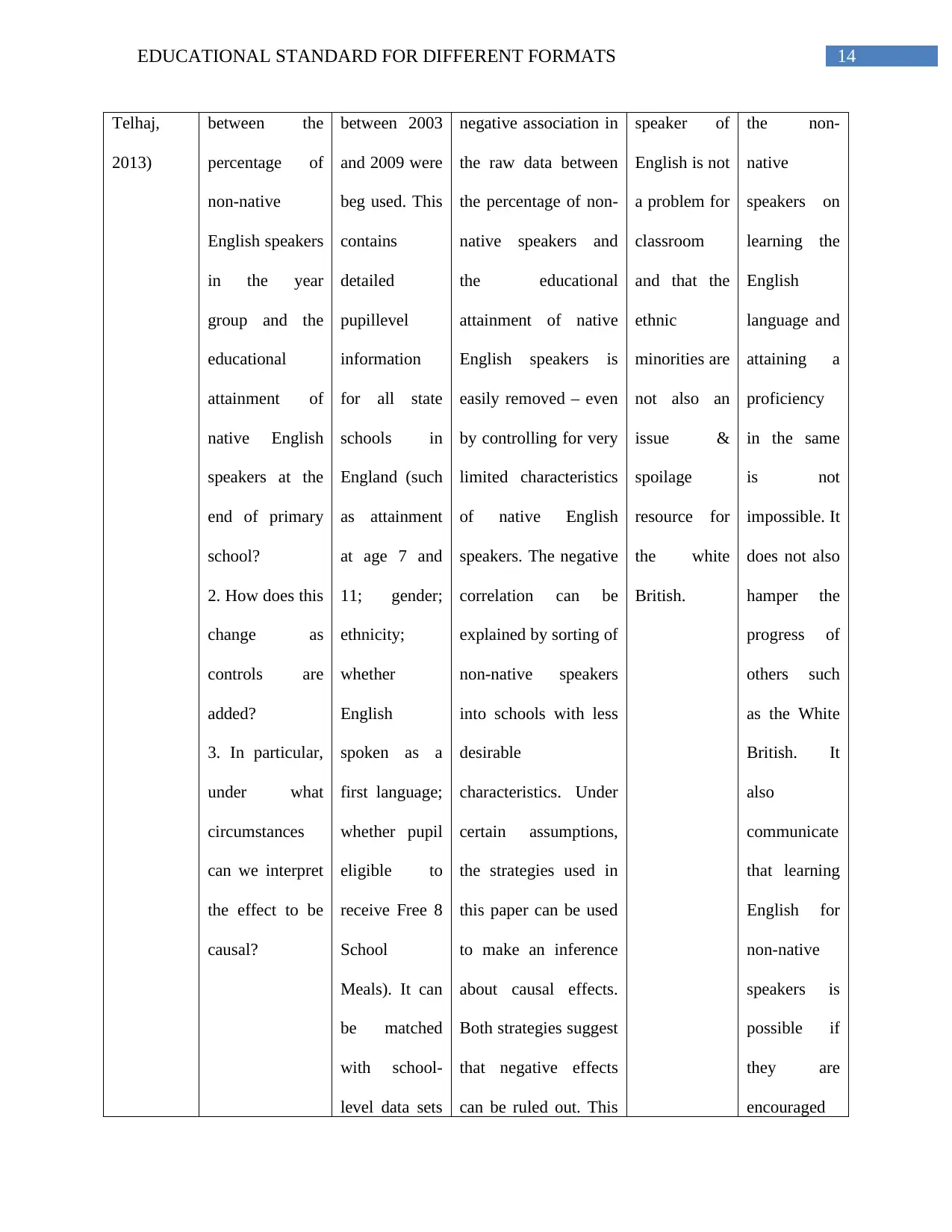
14EDUCATIONAL STANDARD FOR DIFFERENT FORMATS
Telhaj,
2013)
between the
percentage of
non-native
English speakers
in the year
group and the
educational
attainment of
native English
speakers at the
end of primary
school?
2. How does this
change as
controls are
added?
3. In particular,
under what
circumstances
can we interpret
the effect to be
causal?
between 2003
and 2009 were
beg used. This
contains
detailed
pupillevel
information
for all state
schools in
England (such
as attainment
at age 7 and
11; gender;
ethnicity;
whether
English
spoken as a
first language;
whether pupil
eligible to
receive Free 8
School
Meals). It can
be matched
with school-
level data sets
negative association in
the raw data between
the percentage of non-
native speakers and
the educational
attainment of native
English speakers is
easily removed – even
by controlling for very
limited characteristics
of native English
speakers. The negative
correlation can be
explained by sorting of
non-native speakers
into schools with less
desirable
characteristics. Under
certain assumptions,
the strategies used in
this paper can be used
to make an inference
about causal effects.
Both strategies suggest
that negative effects
can be ruled out. This
speaker of
English is not
a problem for
classroom
and that the
ethnic
minorities are
not also an
issue &
spoilage
resource for
the white
British.
the non-
native
speakers on
learning the
English
language and
attaining a
proficiency
in the same
is not
impossible. It
does not also
hamper the
progress of
others such
as the White
British. It
also
communicate
that learning
English for
non-native
speakers is
possible if
they are
encouraged
Telhaj,
2013)
between the
percentage of
non-native
English speakers
in the year
group and the
educational
attainment of
native English
speakers at the
end of primary
school?
2. How does this
change as
controls are
added?
3. In particular,
under what
circumstances
can we interpret
the effect to be
causal?
between 2003
and 2009 were
beg used. This
contains
detailed
pupillevel
information
for all state
schools in
England (such
as attainment
at age 7 and
11; gender;
ethnicity;
whether
English
spoken as a
first language;
whether pupil
eligible to
receive Free 8
School
Meals). It can
be matched
with school-
level data sets
negative association in
the raw data between
the percentage of non-
native speakers and
the educational
attainment of native
English speakers is
easily removed – even
by controlling for very
limited characteristics
of native English
speakers. The negative
correlation can be
explained by sorting of
non-native speakers
into schools with less
desirable
characteristics. Under
certain assumptions,
the strategies used in
this paper can be used
to make an inference
about causal effects.
Both strategies suggest
that negative effects
can be ruled out. This
speaker of
English is not
a problem for
classroom
and that the
ethnic
minorities are
not also an
issue &
spoilage
resource for
the white
British.
the non-
native
speakers on
learning the
English
language and
attaining a
proficiency
in the same
is not
impossible. It
does not also
hamper the
progress of
others such
as the White
British. It
also
communicate
that learning
English for
non-native
speakers is
possible if
they are
encouraged
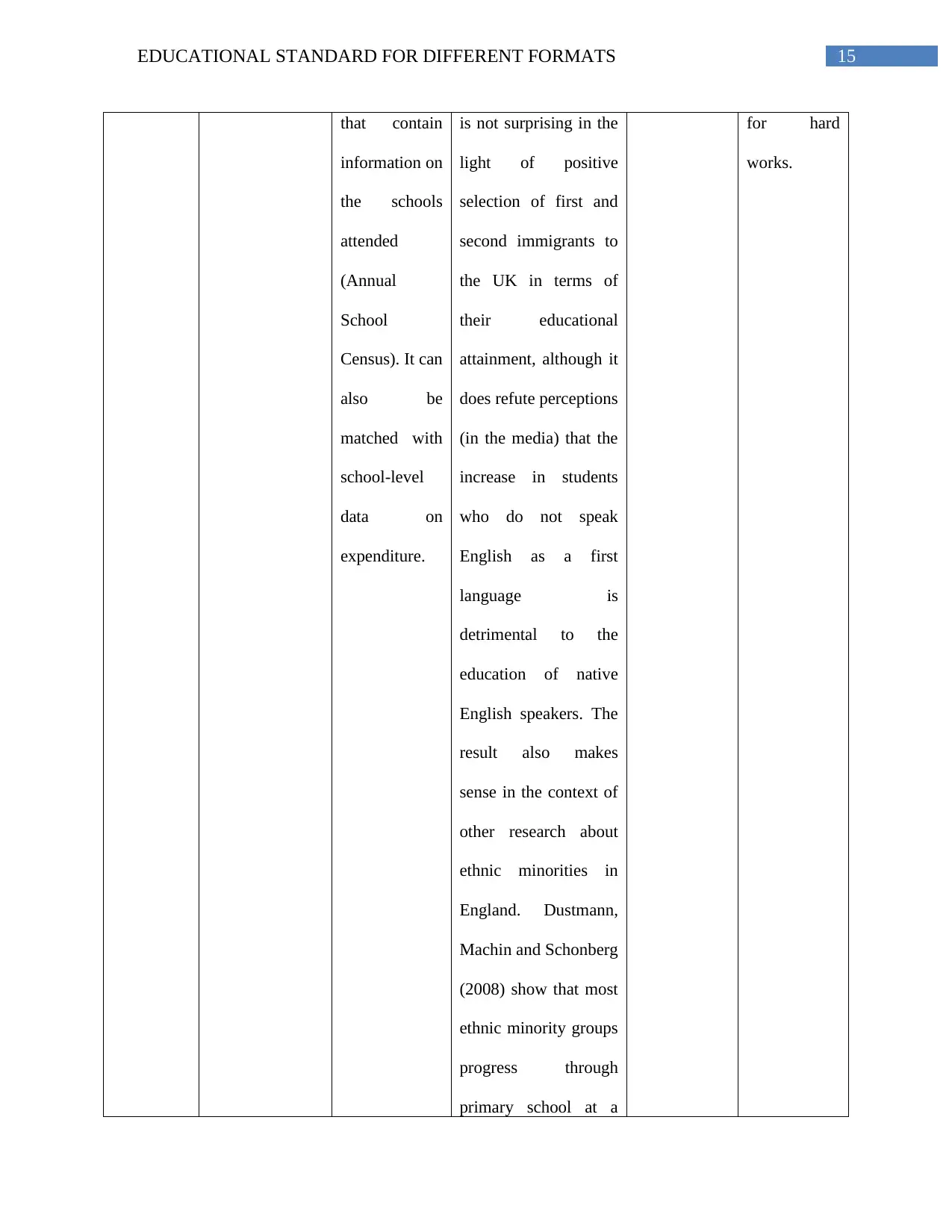
15EDUCATIONAL STANDARD FOR DIFFERENT FORMATS
that contain
information on
the schools
attended
(Annual
School
Census). It can
also be
matched with
school-level
data on
expenditure.
is not surprising in the
light of positive
selection of first and
second immigrants to
the UK in terms of
their educational
attainment, although it
does refute perceptions
(in the media) that the
increase in students
who do not speak
English as a first
language is
detrimental to the
education of native
English speakers. The
result also makes
sense in the context of
other research about
ethnic minorities in
England. Dustmann,
Machin and Schonberg
(2008) show that most
ethnic minority groups
progress through
primary school at a
for hard
works.
that contain
information on
the schools
attended
(Annual
School
Census). It can
also be
matched with
school-level
data on
expenditure.
is not surprising in the
light of positive
selection of first and
second immigrants to
the UK in terms of
their educational
attainment, although it
does refute perceptions
(in the media) that the
increase in students
who do not speak
English as a first
language is
detrimental to the
education of native
English speakers. The
result also makes
sense in the context of
other research about
ethnic minorities in
England. Dustmann,
Machin and Schonberg
(2008) show that most
ethnic minority groups
progress through
primary school at a
for hard
works.
Secure Best Marks with AI Grader
Need help grading? Try our AI Grader for instant feedback on your assignments.
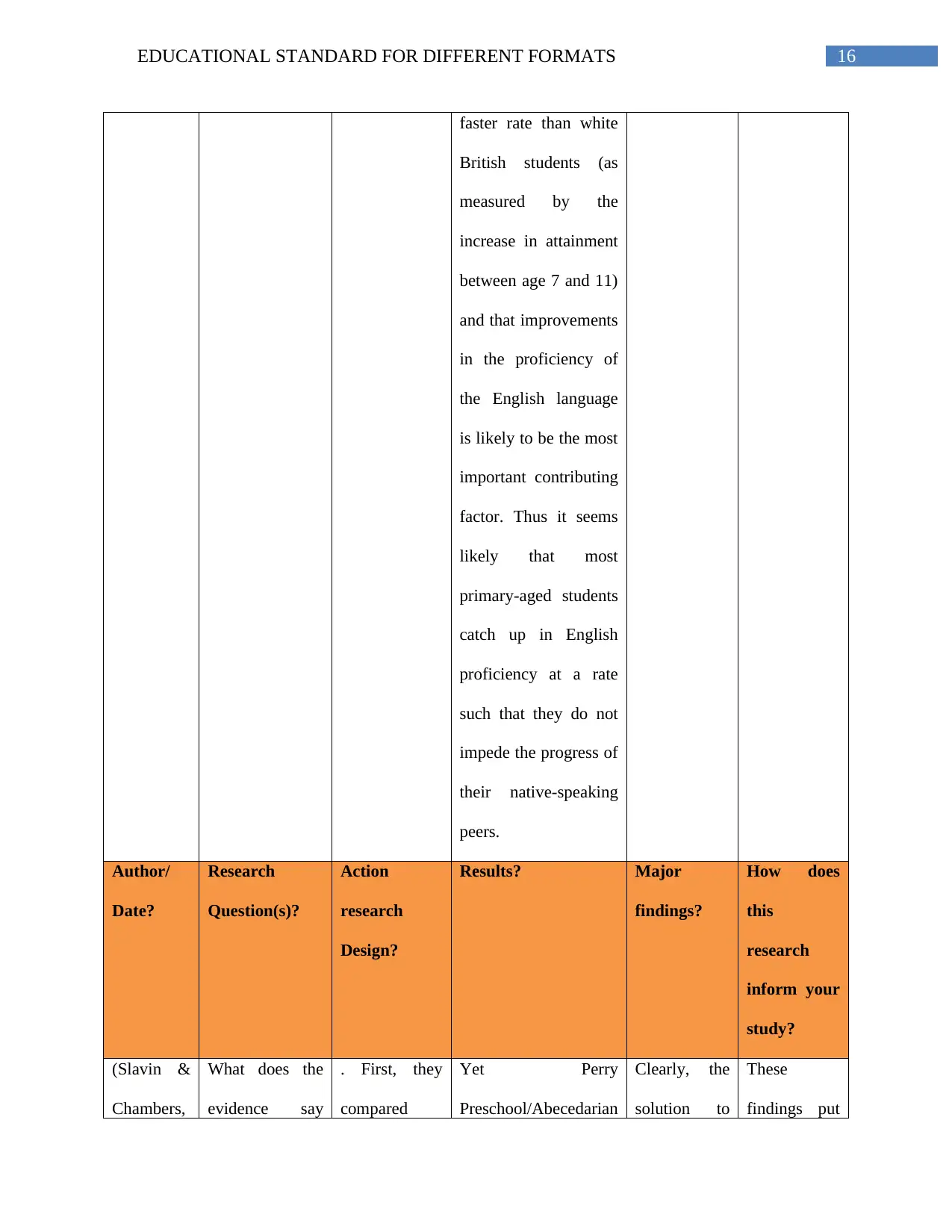
16EDUCATIONAL STANDARD FOR DIFFERENT FORMATS
faster rate than white
British students (as
measured by the
increase in attainment
between age 7 and 11)
and that improvements
in the proficiency of
the English language
is likely to be the most
important contributing
factor. Thus it seems
likely that most
primary-aged students
catch up in English
proficiency at a rate
such that they do not
impede the progress of
their native-speaking
peers.
Author/
Date?
Research
Question(s)?
Action
research
Design?
Results? Major
findings?
How does
this
research
inform your
study?
(Slavin &
Chambers,
What does the
evidence say
. First, they
compared
Yet Perry
Preschool/Abecedarian
Clearly, the
solution to
These
findings put
faster rate than white
British students (as
measured by the
increase in attainment
between age 7 and 11)
and that improvements
in the proficiency of
the English language
is likely to be the most
important contributing
factor. Thus it seems
likely that most
primary-aged students
catch up in English
proficiency at a rate
such that they do not
impede the progress of
their native-speaking
peers.
Author/
Date?
Research
Question(s)?
Action
research
Design?
Results? Major
findings?
How does
this
research
inform your
study?
(Slavin &
Chambers,
What does the
evidence say
. First, they
compared
Yet Perry
Preschool/Abecedarian
Clearly, the
solution to
These
findings put
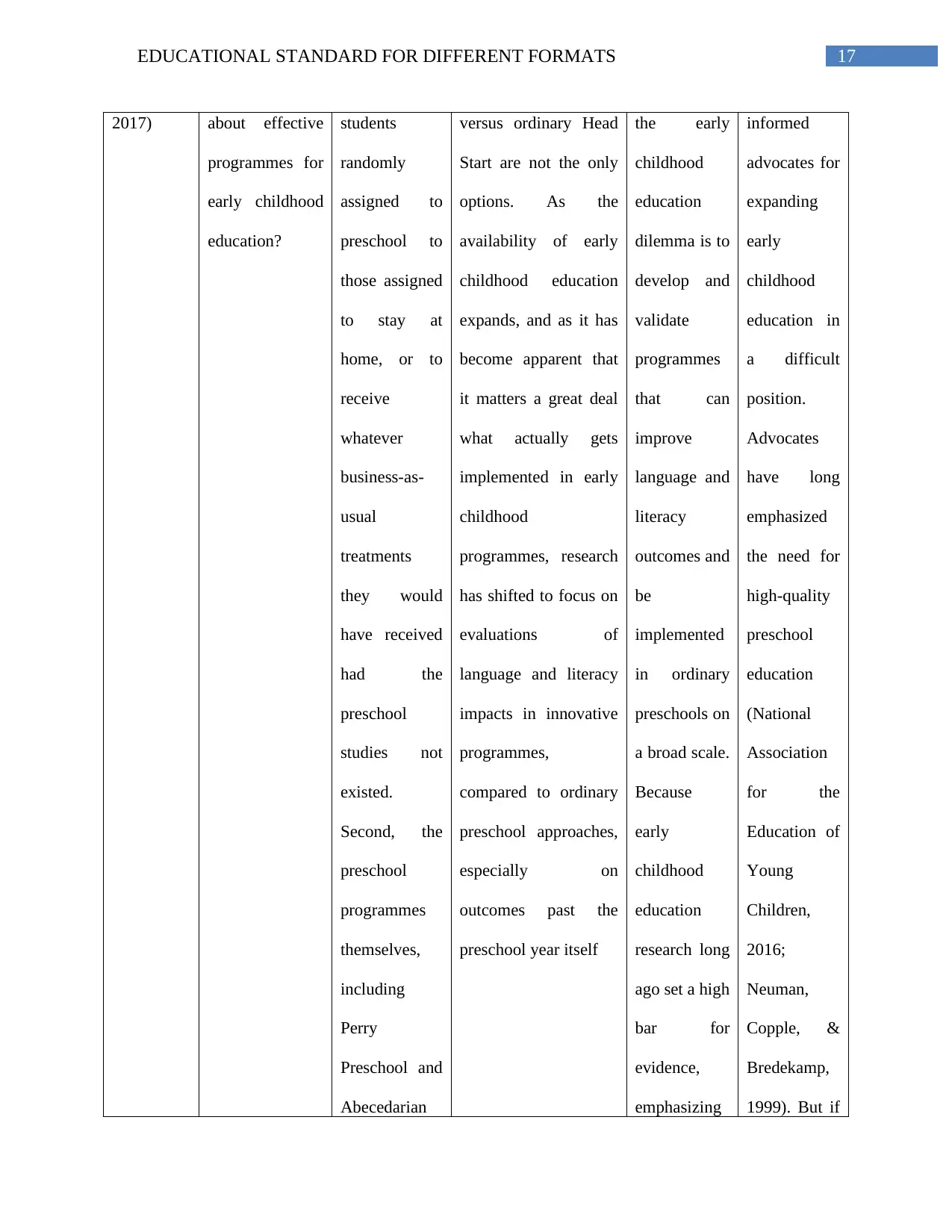
17EDUCATIONAL STANDARD FOR DIFFERENT FORMATS
2017) about effective
programmes for
early childhood
education?
students
randomly
assigned to
preschool to
those assigned
to stay at
home, or to
receive
whatever
business-as-
usual
treatments
they would
have received
had the
preschool
studies not
existed.
Second, the
preschool
programmes
themselves,
including
Perry
Preschool and
Abecedarian
versus ordinary Head
Start are not the only
options. As the
availability of early
childhood education
expands, and as it has
become apparent that
it matters a great deal
what actually gets
implemented in early
childhood
programmes, research
has shifted to focus on
evaluations of
language and literacy
impacts in innovative
programmes,
compared to ordinary
preschool approaches,
especially on
outcomes past the
preschool year itself
the early
childhood
education
dilemma is to
develop and
validate
programmes
that can
improve
language and
literacy
outcomes and
be
implemented
in ordinary
preschools on
a broad scale.
Because
early
childhood
education
research long
ago set a high
bar for
evidence,
emphasizing
informed
advocates for
expanding
early
childhood
education in
a difficult
position.
Advocates
have long
emphasized
the need for
high-quality
preschool
education
(National
Association
for the
Education of
Young
Children,
2016;
Neuman,
Copple, &
Bredekamp,
1999). But if
2017) about effective
programmes for
early childhood
education?
students
randomly
assigned to
preschool to
those assigned
to stay at
home, or to
receive
whatever
business-as-
usual
treatments
they would
have received
had the
preschool
studies not
existed.
Second, the
preschool
programmes
themselves,
including
Perry
Preschool and
Abecedarian
versus ordinary Head
Start are not the only
options. As the
availability of early
childhood education
expands, and as it has
become apparent that
it matters a great deal
what actually gets
implemented in early
childhood
programmes, research
has shifted to focus on
evaluations of
language and literacy
impacts in innovative
programmes,
compared to ordinary
preschool approaches,
especially on
outcomes past the
preschool year itself
the early
childhood
education
dilemma is to
develop and
validate
programmes
that can
improve
language and
literacy
outcomes and
be
implemented
in ordinary
preschools on
a broad scale.
Because
early
childhood
education
research long
ago set a high
bar for
evidence,
emphasizing
informed
advocates for
expanding
early
childhood
education in
a difficult
position.
Advocates
have long
emphasized
the need for
high-quality
preschool
education
(National
Association
for the
Education of
Young
Children,
2016;
Neuman,
Copple, &
Bredekamp,
1999). But if
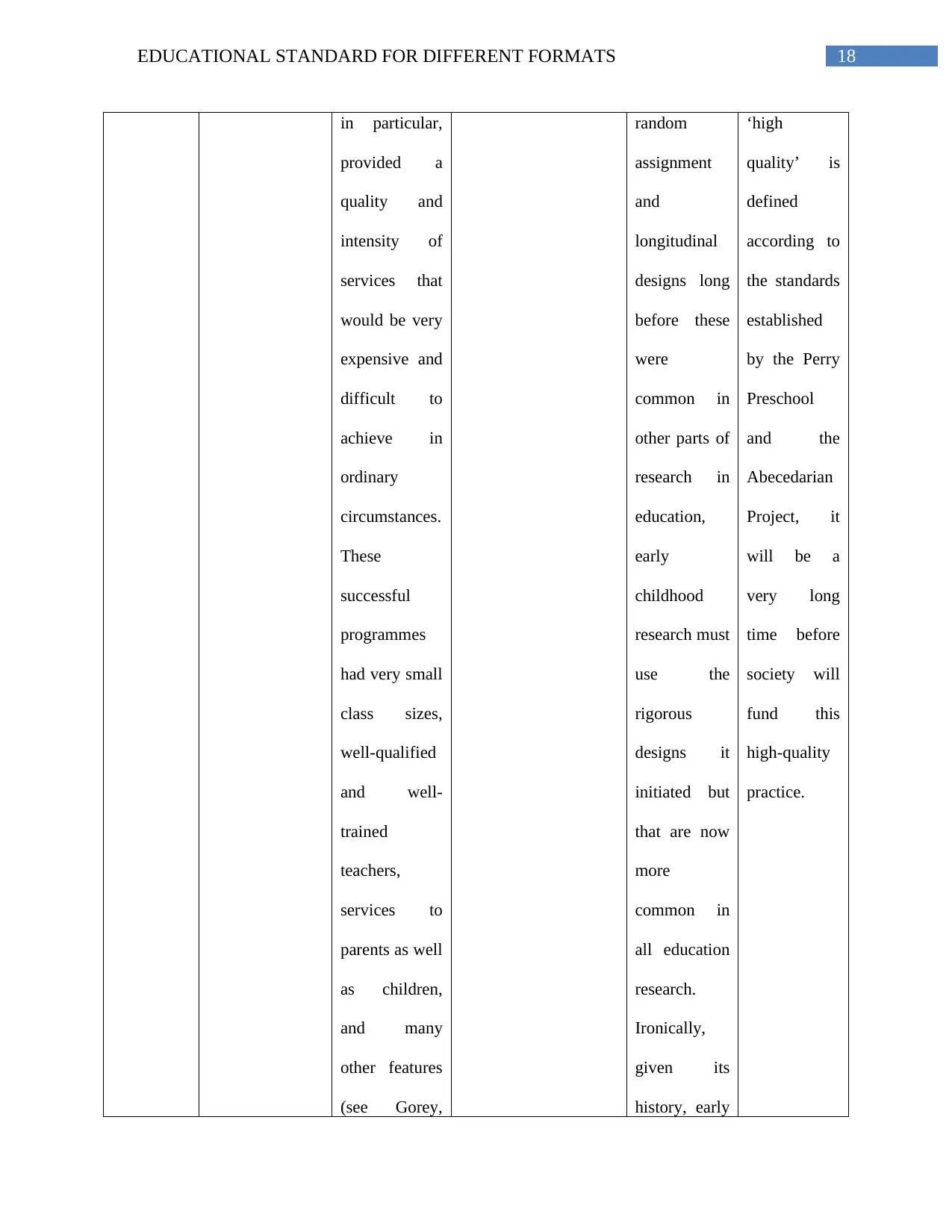
18EDUCATIONAL STANDARD FOR DIFFERENT FORMATS
in particular,
provided a
quality and
intensity of
services that
would be very
expensive and
difficult to
achieve in
ordinary
circumstances.
These
successful
programmes
had very small
class sizes,
well-qualified
and well-
trained
teachers,
services to
parents as well
as children,
and many
other features
(see Gorey,
random
assignment
and
longitudinal
designs long
before these
were
common in
other parts of
research in
education,
early
childhood
research must
use the
rigorous
designs it
initiated but
that are now
more
common in
all education
research.
Ironically,
given its
history, early
‘high
quality’ is
defined
according to
the standards
established
by the Perry
Preschool
and the
Abecedarian
Project, it
will be a
very long
time before
society will
fund this
high-quality
practice.
in particular,
provided a
quality and
intensity of
services that
would be very
expensive and
difficult to
achieve in
ordinary
circumstances.
These
successful
programmes
had very small
class sizes,
well-qualified
and well-
trained
teachers,
services to
parents as well
as children,
and many
other features
(see Gorey,
random
assignment
and
longitudinal
designs long
before these
were
common in
other parts of
research in
education,
early
childhood
research must
use the
rigorous
designs it
initiated but
that are now
more
common in
all education
research.
Ironically,
given its
history, early
‘high
quality’ is
defined
according to
the standards
established
by the Perry
Preschool
and the
Abecedarian
Project, it
will be a
very long
time before
society will
fund this
high-quality
practice.
Paraphrase This Document
Need a fresh take? Get an instant paraphrase of this document with our AI Paraphraser
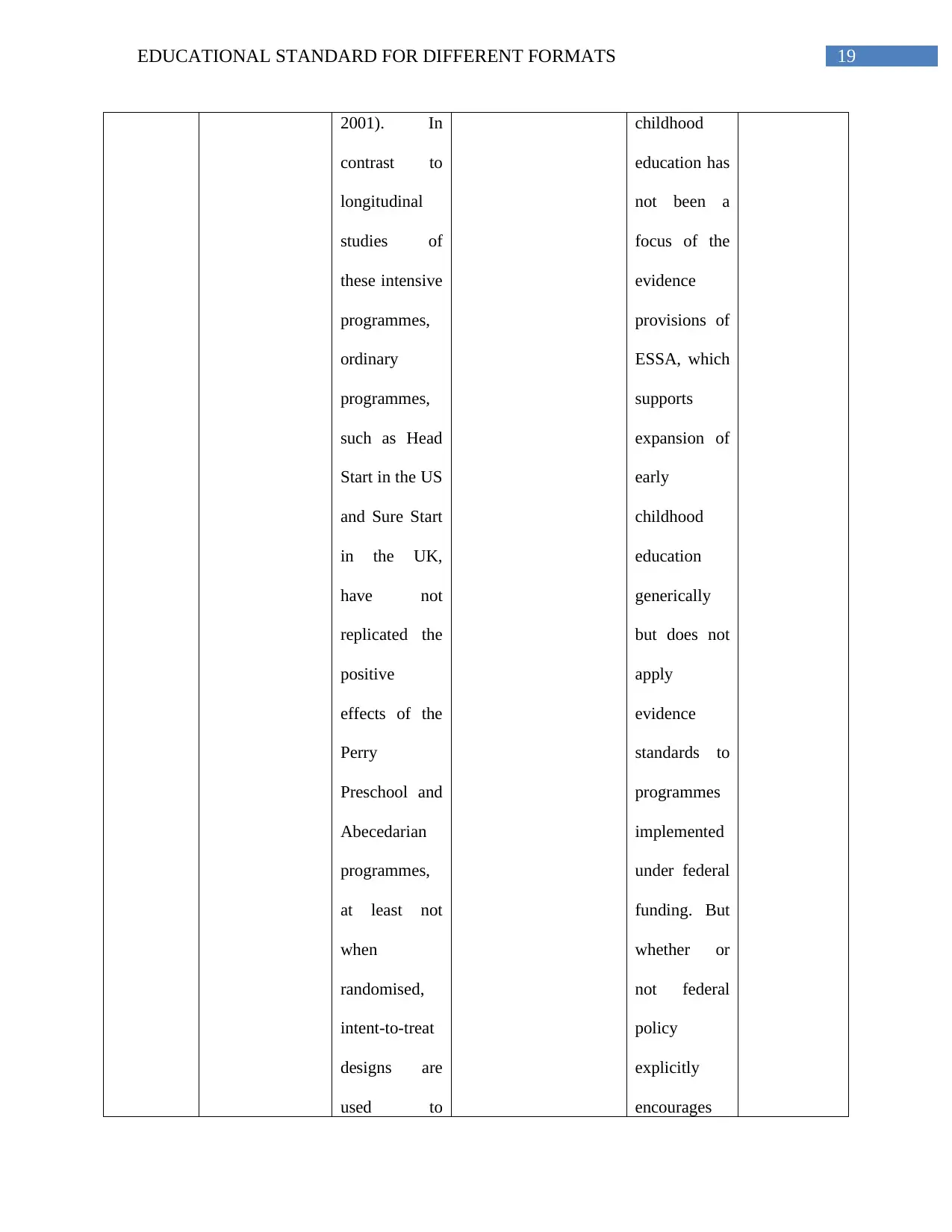
19EDUCATIONAL STANDARD FOR DIFFERENT FORMATS
2001). In
contrast to
longitudinal
studies of
these intensive
programmes,
ordinary
programmes,
such as Head
Start in the US
and Sure Start
in the UK,
have not
replicated the
positive
effects of the
Perry
Preschool and
Abecedarian
programmes,
at least not
when
randomised,
intent-to-treat
designs are
used to
childhood
education has
not been a
focus of the
evidence
provisions of
ESSA, which
supports
expansion of
early
childhood
education
generically
but does not
apply
evidence
standards to
programmes
implemented
under federal
funding. But
whether or
not federal
policy
explicitly
encourages
2001). In
contrast to
longitudinal
studies of
these intensive
programmes,
ordinary
programmes,
such as Head
Start in the US
and Sure Start
in the UK,
have not
replicated the
positive
effects of the
Perry
Preschool and
Abecedarian
programmes,
at least not
when
randomised,
intent-to-treat
designs are
used to
childhood
education has
not been a
focus of the
evidence
provisions of
ESSA, which
supports
expansion of
early
childhood
education
generically
but does not
apply
evidence
standards to
programmes
implemented
under federal
funding. But
whether or
not federal
policy
explicitly
encourages
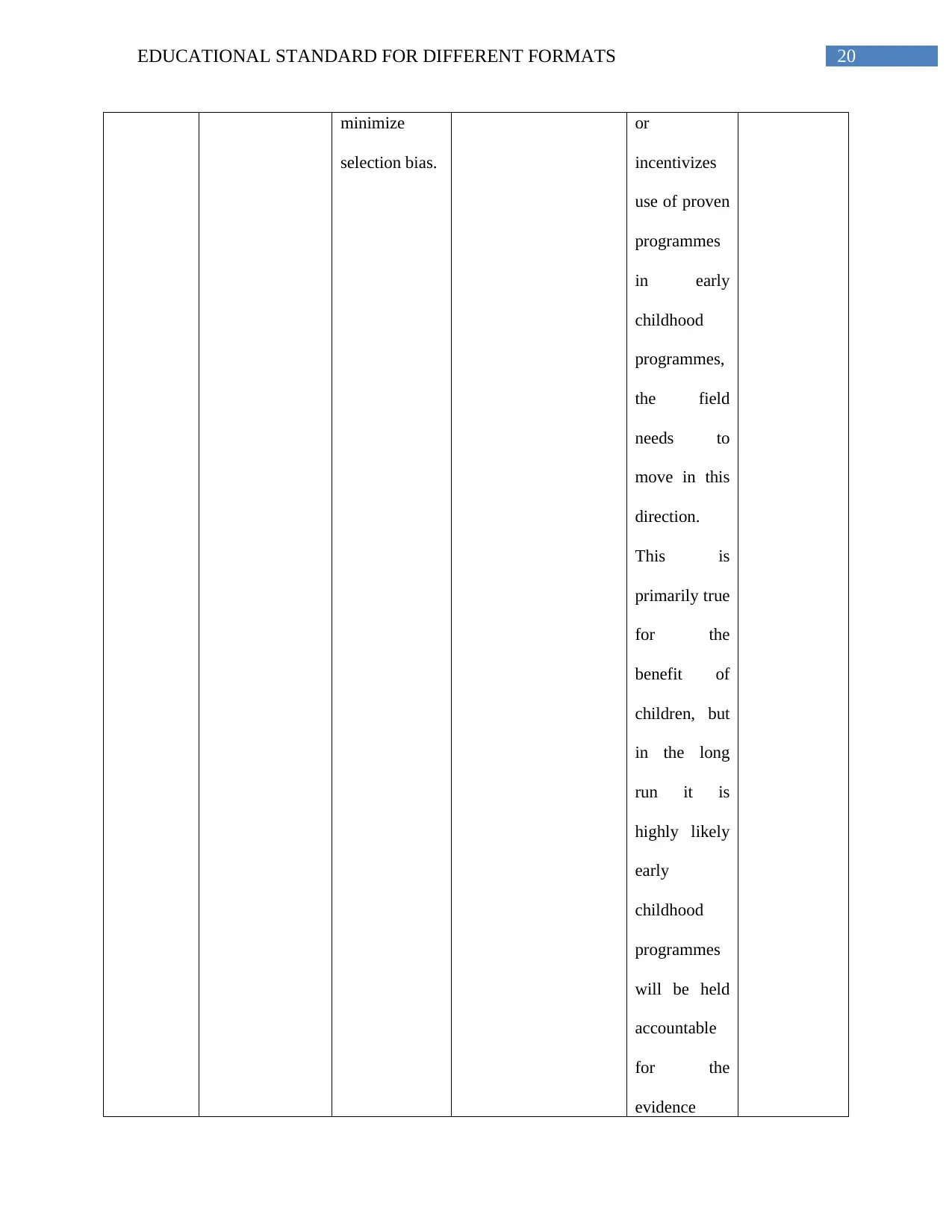
20EDUCATIONAL STANDARD FOR DIFFERENT FORMATS
minimize
selection bias.
or
incentivizes
use of proven
programmes
in early
childhood
programmes,
the field
needs to
move in this
direction.
This is
primarily true
for the
benefit of
children, but
in the long
run it is
highly likely
early
childhood
programmes
will be held
accountable
for the
evidence
minimize
selection bias.
or
incentivizes
use of proven
programmes
in early
childhood
programmes,
the field
needs to
move in this
direction.
This is
primarily true
for the
benefit of
children, but
in the long
run it is
highly likely
early
childhood
programmes
will be held
accountable
for the
evidence
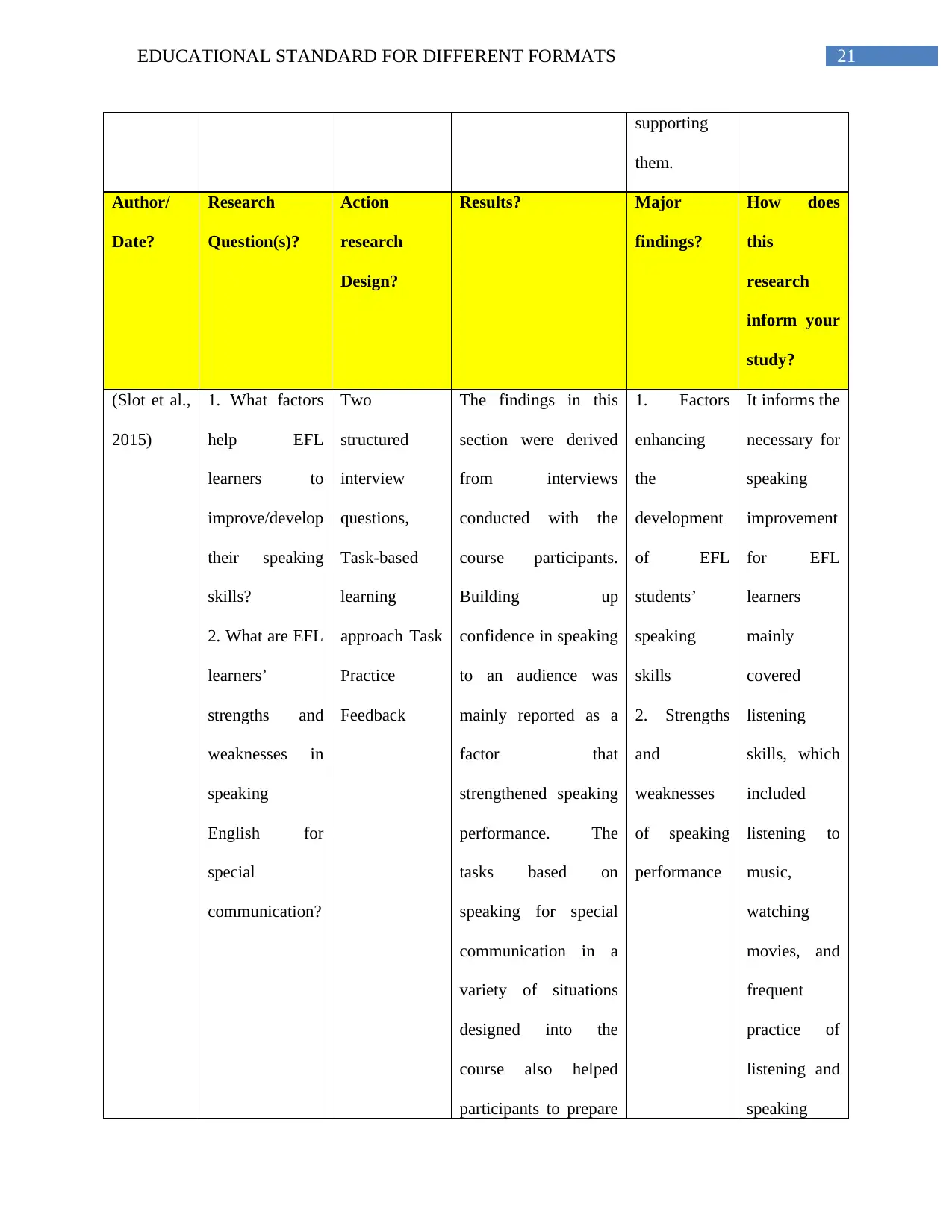
21EDUCATIONAL STANDARD FOR DIFFERENT FORMATS
supporting
them.
Author/
Date?
Research
Question(s)?
Action
research
Design?
Results? Major
findings?
How does
this
research
inform your
study?
(Slot et al.,
2015)
1. What factors
help EFL
learners to
improve/develop
their speaking
skills?
2. What are EFL
learners’
strengths and
weaknesses in
speaking
English for
special
communication?
Two
structured
interview
questions,
Task-based
learning
approach Task
Practice
Feedback
The findings in this
section were derived
from interviews
conducted with the
course participants.
Building up
confidence in speaking
to an audience was
mainly reported as a
factor that
strengthened speaking
performance. The
tasks based on
speaking for special
communication in a
variety of situations
designed into the
course also helped
participants to prepare
1. Factors
enhancing
the
development
of EFL
students’
speaking
skills
2. Strengths
and
weaknesses
of speaking
performance
It informs the
necessary for
speaking
improvement
for EFL
learners
mainly
covered
listening
skills, which
included
listening to
music,
watching
movies, and
frequent
practice of
listening and
speaking
supporting
them.
Author/
Date?
Research
Question(s)?
Action
research
Design?
Results? Major
findings?
How does
this
research
inform your
study?
(Slot et al.,
2015)
1. What factors
help EFL
learners to
improve/develop
their speaking
skills?
2. What are EFL
learners’
strengths and
weaknesses in
speaking
English for
special
communication?
Two
structured
interview
questions,
Task-based
learning
approach Task
Practice
Feedback
The findings in this
section were derived
from interviews
conducted with the
course participants.
Building up
confidence in speaking
to an audience was
mainly reported as a
factor that
strengthened speaking
performance. The
tasks based on
speaking for special
communication in a
variety of situations
designed into the
course also helped
participants to prepare
1. Factors
enhancing
the
development
of EFL
students’
speaking
skills
2. Strengths
and
weaknesses
of speaking
performance
It informs the
necessary for
speaking
improvement
for EFL
learners
mainly
covered
listening
skills, which
included
listening to
music,
watching
movies, and
frequent
practice of
listening and
speaking
Secure Best Marks with AI Grader
Need help grading? Try our AI Grader for instant feedback on your assignments.
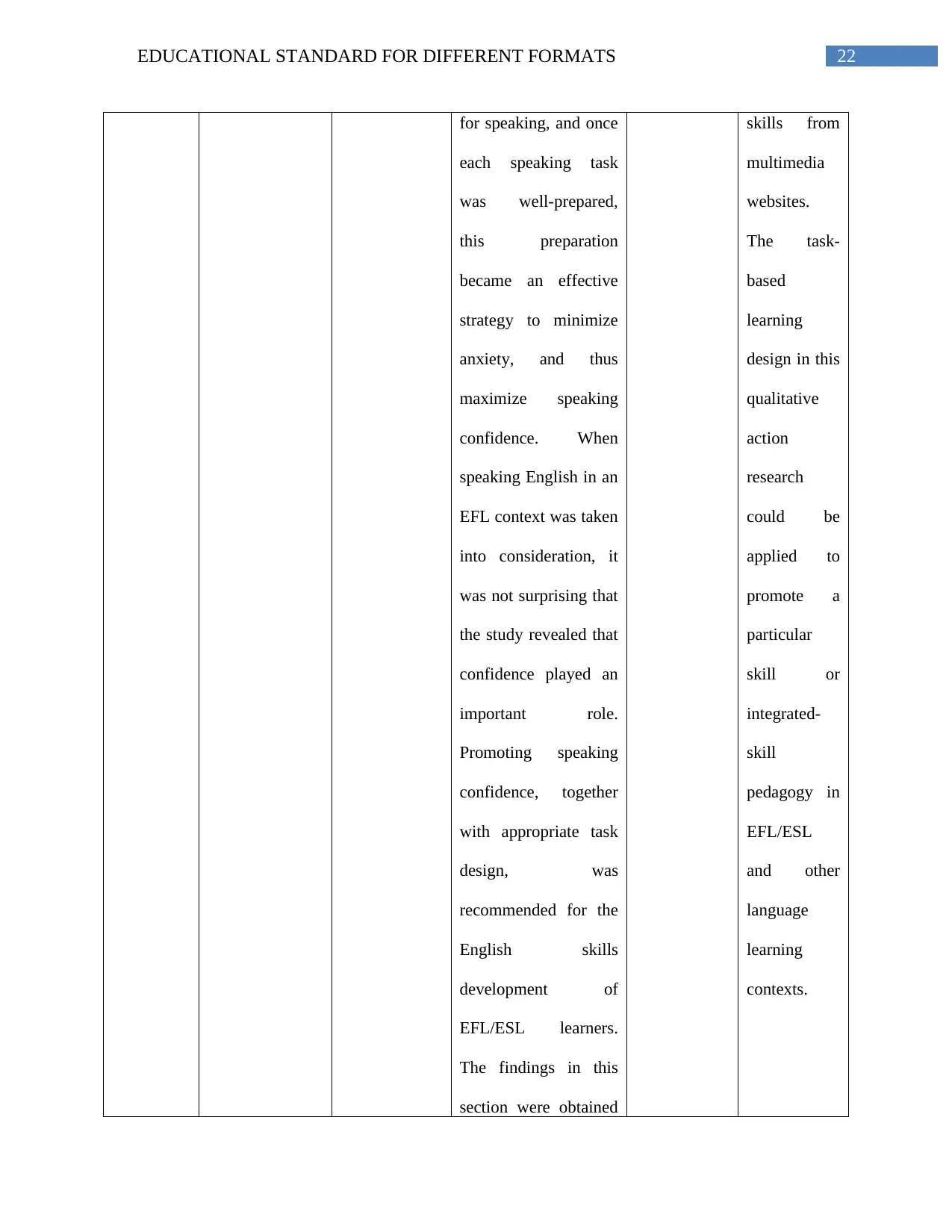
22EDUCATIONAL STANDARD FOR DIFFERENT FORMATS
for speaking, and once
each speaking task
was well-prepared,
this preparation
became an effective
strategy to minimize
anxiety, and thus
maximize speaking
confidence. When
speaking English in an
EFL context was taken
into consideration, it
was not surprising that
the study revealed that
confidence played an
important role.
Promoting speaking
confidence, together
with appropriate task
design, was
recommended for the
English skills
development of
EFL/ESL learners.
The findings in this
section were obtained
skills from
multimedia
websites.
The task-
based
learning
design in this
qualitative
action
research
could be
applied to
promote a
particular
skill or
integrated-
skill
pedagogy in
EFL/ESL
and other
language
learning
contexts.
for speaking, and once
each speaking task
was well-prepared,
this preparation
became an effective
strategy to minimize
anxiety, and thus
maximize speaking
confidence. When
speaking English in an
EFL context was taken
into consideration, it
was not surprising that
the study revealed that
confidence played an
important role.
Promoting speaking
confidence, together
with appropriate task
design, was
recommended for the
English skills
development of
EFL/ESL learners.
The findings in this
section were obtained
skills from
multimedia
websites.
The task-
based
learning
design in this
qualitative
action
research
could be
applied to
promote a
particular
skill or
integrated-
skill
pedagogy in
EFL/ESL
and other
language
learning
contexts.
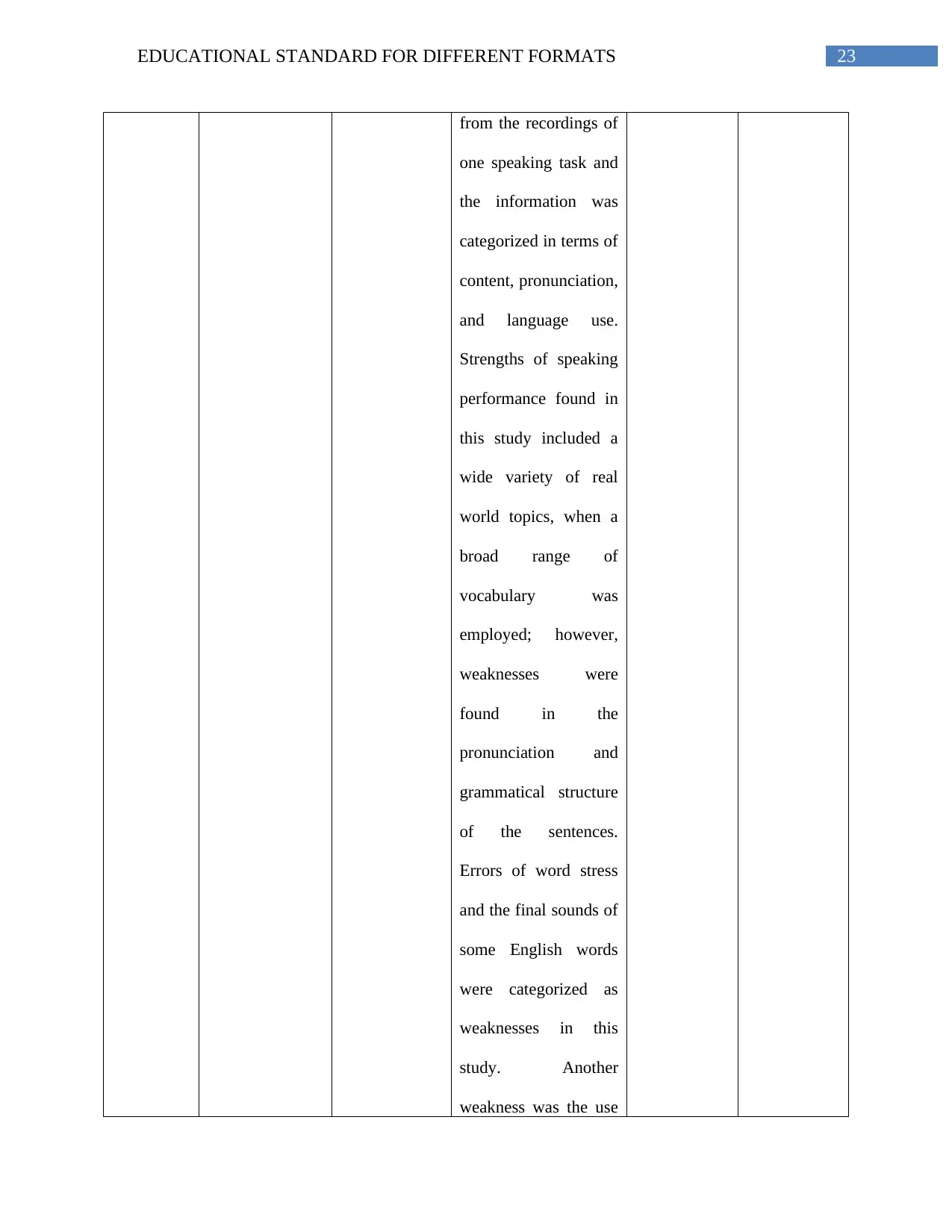
23EDUCATIONAL STANDARD FOR DIFFERENT FORMATS
from the recordings of
one speaking task and
the information was
categorized in terms of
content, pronunciation,
and language use.
Strengths of speaking
performance found in
this study included a
wide variety of real
world topics, when a
broad range of
vocabulary was
employed; however,
weaknesses were
found in the
pronunciation and
grammatical structure
of the sentences.
Errors of word stress
and the final sounds of
some English words
were categorized as
weaknesses in this
study. Another
weakness was the use
from the recordings of
one speaking task and
the information was
categorized in terms of
content, pronunciation,
and language use.
Strengths of speaking
performance found in
this study included a
wide variety of real
world topics, when a
broad range of
vocabulary was
employed; however,
weaknesses were
found in the
pronunciation and
grammatical structure
of the sentences.
Errors of word stress
and the final sounds of
some English words
were categorized as
weaknesses in this
study. Another
weakness was the use
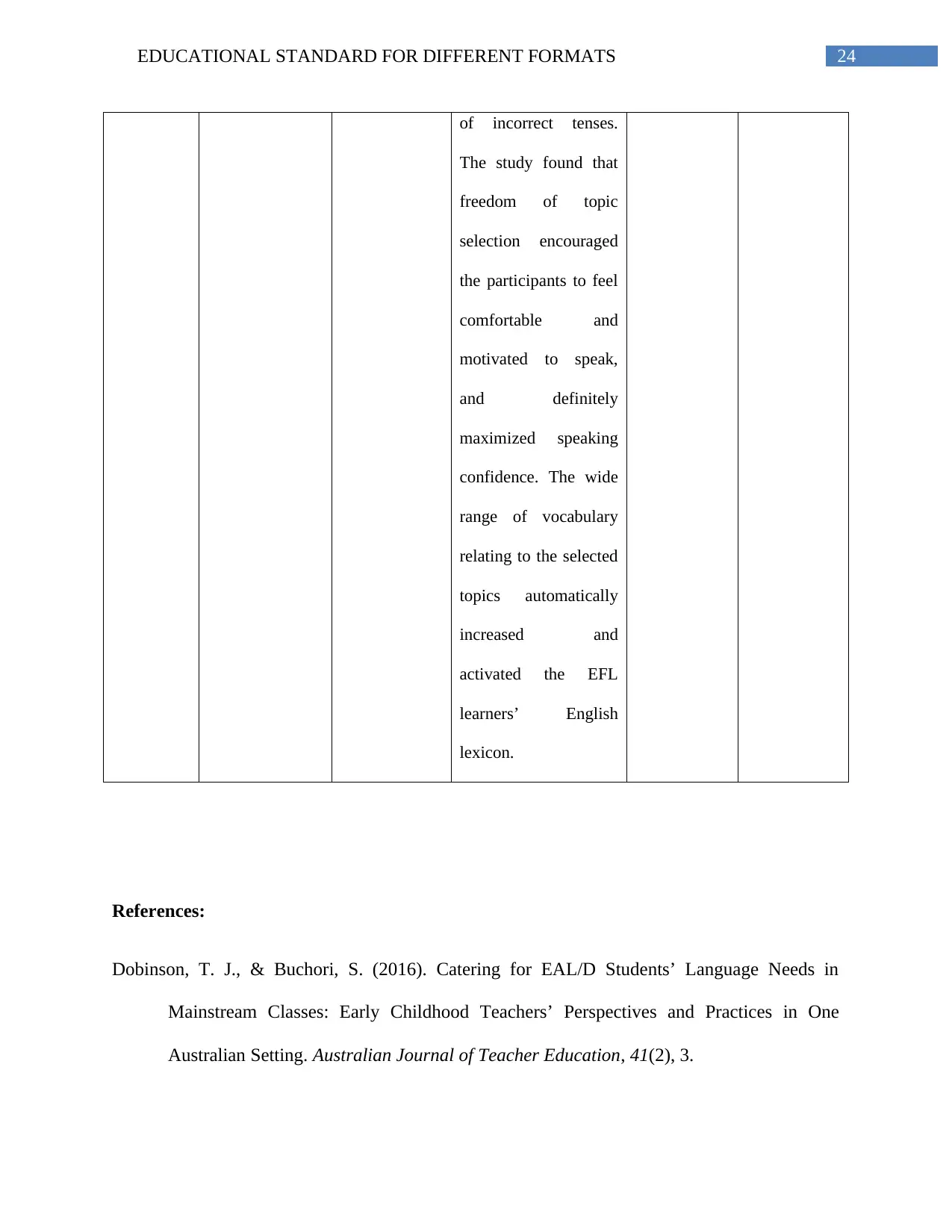
24EDUCATIONAL STANDARD FOR DIFFERENT FORMATS
of incorrect tenses.
The study found that
freedom of topic
selection encouraged
the participants to feel
comfortable and
motivated to speak,
and definitely
maximized speaking
confidence. The wide
range of vocabulary
relating to the selected
topics automatically
increased and
activated the EFL
learners’ English
lexicon.
References:
Dobinson, T. J., & Buchori, S. (2016). Catering for EAL/D Students’ Language Needs in
Mainstream Classes: Early Childhood Teachers’ Perspectives and Practices in One
Australian Setting. Australian Journal of Teacher Education, 41(2), 3.
of incorrect tenses.
The study found that
freedom of topic
selection encouraged
the participants to feel
comfortable and
motivated to speak,
and definitely
maximized speaking
confidence. The wide
range of vocabulary
relating to the selected
topics automatically
increased and
activated the EFL
learners’ English
lexicon.
References:
Dobinson, T. J., & Buchori, S. (2016). Catering for EAL/D Students’ Language Needs in
Mainstream Classes: Early Childhood Teachers’ Perspectives and Practices in One
Australian Setting. Australian Journal of Teacher Education, 41(2), 3.
Paraphrase This Document
Need a fresh take? Get an instant paraphrase of this document with our AI Paraphraser
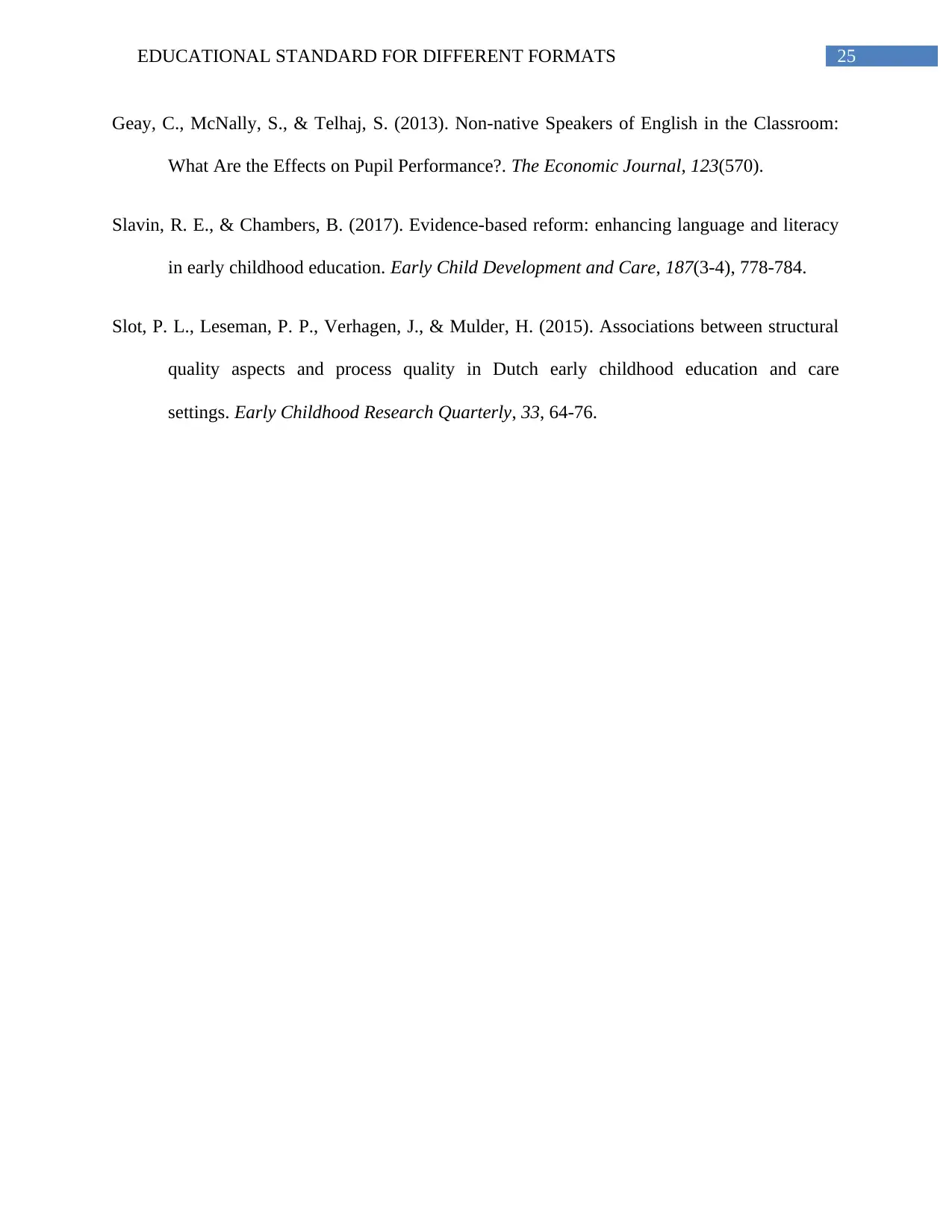
25EDUCATIONAL STANDARD FOR DIFFERENT FORMATS
Geay, C., McNally, S., & Telhaj, S. (2013). Non‐native Speakers of English in the Classroom:
What Are the Effects on Pupil Performance?. The Economic Journal, 123(570).
Slavin, R. E., & Chambers, B. (2017). Evidence-based reform: enhancing language and literacy
in early childhood education. Early Child Development and Care, 187(3-4), 778-784.
Slot, P. L., Leseman, P. P., Verhagen, J., & Mulder, H. (2015). Associations between structural
quality aspects and process quality in Dutch early childhood education and care
settings. Early Childhood Research Quarterly, 33, 64-76.
Geay, C., McNally, S., & Telhaj, S. (2013). Non‐native Speakers of English in the Classroom:
What Are the Effects on Pupil Performance?. The Economic Journal, 123(570).
Slavin, R. E., & Chambers, B. (2017). Evidence-based reform: enhancing language and literacy
in early childhood education. Early Child Development and Care, 187(3-4), 778-784.
Slot, P. L., Leseman, P. P., Verhagen, J., & Mulder, H. (2015). Associations between structural
quality aspects and process quality in Dutch early childhood education and care
settings. Early Childhood Research Quarterly, 33, 64-76.
1 out of 26
Your All-in-One AI-Powered Toolkit for Academic Success.
+13062052269
info@desklib.com
Available 24*7 on WhatsApp / Email
![[object Object]](/_next/static/media/star-bottom.7253800d.svg)
Unlock your academic potential
© 2024 | Zucol Services PVT LTD | All rights reserved.
